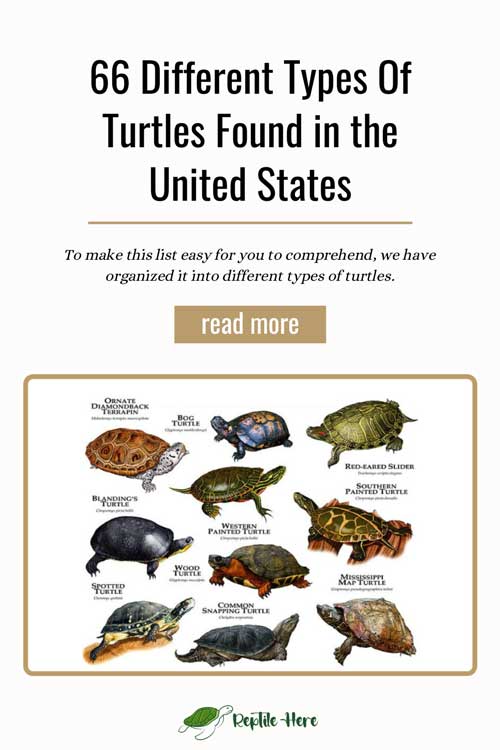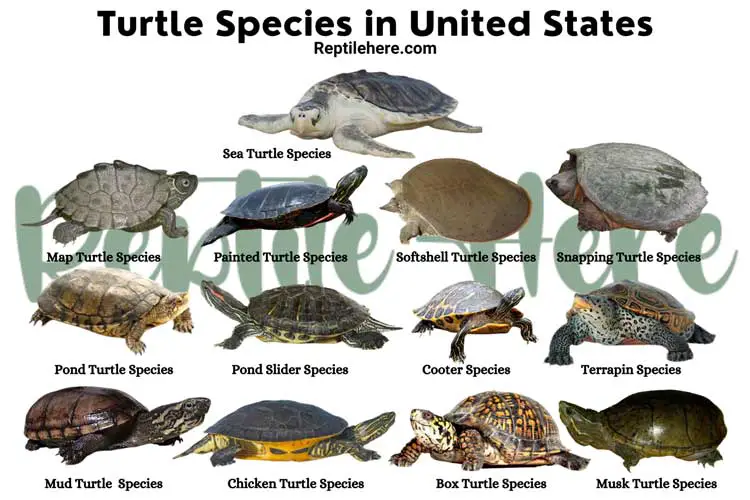66 Different Types Of Turtles Found in the United States
There are over 356 different species of turtles in the world. And the United States is home to 20% of these species.
Even better, the US boasts its position as a hotspot for turtle diversity and has the largest list of native turtle species than any other country.
Some common turtles you’ll find are snapping turtles, painted turtles, box turtles, terrapins, chicken turtles pond sliders Cooters, mud turtles, musk turtles, wood turtles, etc.
The turtles of the US are widespread across all its 50 states—with some, like Alabama state accommodating over 30 species.
Unfortunately, some north American turtles are labeled as endangered or threatened.
Their populations have been on a downward trend due to various threats, including climatic change, habitat loss, invasive species and diseases, death from predators and human hunting, and illegal trafficking.
Our comprehensive guide below walks you through the list of different species of turtles in the United States and key facts about each of them, like physical appearance, habitat, diet, and more.
PS: To make this list easy for you to comprehend, we have organized it into different types of turtles.
66 Types Of Turtles In The United States
Contents
Snapping Turtles:
1. Alligator Snapping Turtle
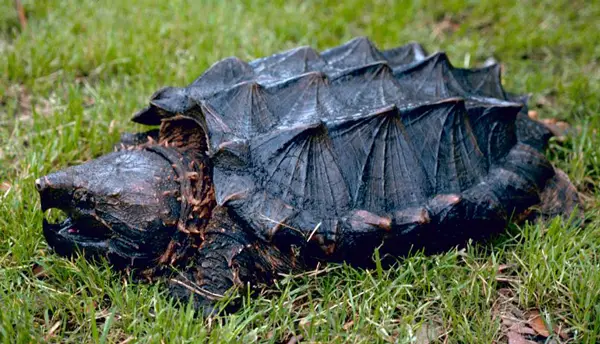
- Scientific name: Macroclemys temminckii
- Common name: Alligator snapping turtle, Snapping turtle
- Family: Chelydridae
- Size: 15 to 26 inches
- Lifespan: 80 to 120 years
- Conservation status: Vulnerable
The alligator snapping turtle inhabits Arkansas, Louisiana, Alabama, Florida, Georgia, Mississippi, Illinois, Texas, Indiana, Kentucky, Kansas, Missouri, Oklahoma, Tennessee, and Wyoming.
This species is large than the common snapping turtle. An adult alligator snapping turtle weighs 15 to 20 inches long.
An alligator turtle is characterized by a long, tough shell with trigonal ridges resembling the alligator’s back (hence the name alligator turtle). Shell coloring can be black, olive, or brown.
Though some people believe that the green tips on the shell ridges are natural, they’re simply algae.
These alligator turtles also prefer living in deeper waters of rivers, canals, lakes, and swamps.
As omnivorous species, they hunt their prey (but not actively). They have a unique way of hunting where they lie at the bottom of the water body and open their mouth to show their pink work-like appendage to lure their prey.
And when the prey gets close enough, the turtle ambushes it!
Another interesting fact about this turtle is its powerful jaws which can bite with a force of up to 1000lbs!
This makes them extremely dangerous turtles and should NEVER be handled in the wild! Mind you, they have injured even the most experienced herpetologists with their bites.
2. Common Snapping Turtle
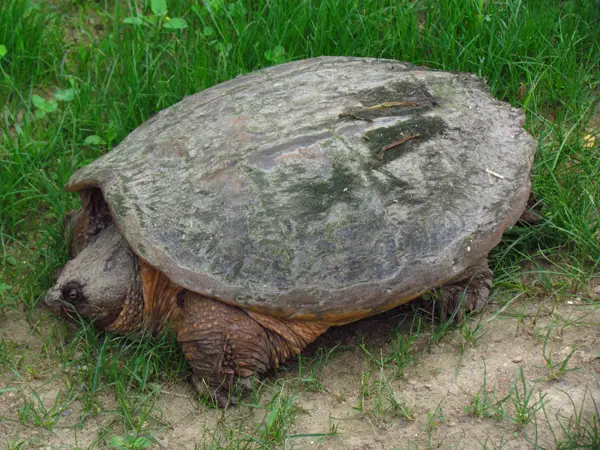
- Scientific name: Chelydra serpentina
- Common name: Snapping Turtle
- Family: Chelydridae
- Size: 8 to 18 1/2 inches
- Lifespan: 30 to 50 years or more
- Conservation status: Least Concern
Common snapping turtles are widespread throughout the US and are present in nearly all 50 states.
An average adult is pretty large and has a shell length of 18½ inches long. This species has a chunky head, a long tail, and large webbed feet. The shell color is black or olive and has no distinct pattern.
These snapping turtles are known for their powerful jaws—they’re so strong that these turtles eat other turtles!
You’ll find them in waterbodies with muddy bottoms. Examples include marshes, ponds, lakes, rivers, and even shallow streams. They generally prefer waters with aquatic vegetation in plenty and foods such as fish, frogs, birds, etc.
These turtles generally show docile behavior but can get quite aggressive if taken out of water. The best way to calm it is to take it back to the waters, where it feels safe.
Softshell Turtles:
3. Florida Softshell Turtle
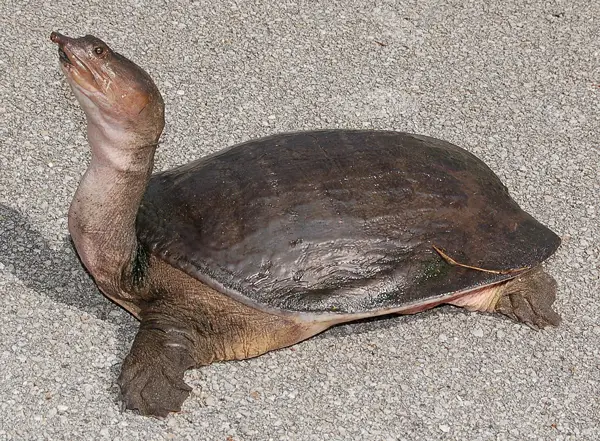
- Scientific name: Apalone ferox
- Common name: Florida Softshell Turtle, Softshell Turtle
- Family: Trionychidae
- Size: 11 to 24 inches (females), 6 to 12 inches (males)
- Lifespan: 50+ years
- Conservation status: Least Concern
Florida softshell turtle is the largest softshell species native to the regions of Alabama, Georgia, South Carolina, and Florida!
This softshell species is marked by a dark brown to olive green upper shell with a leathery texture and pancake appearance. The plastron is usually white or gray.
Florida softshell turtles are mainly carnivorous and will feed on insects, worms, mollusks, and fish strips.
The turtle is almost fully aquatic and prefers residing in shallow and muddy water bodies like slow-moving streams and ponds. Its thin snout enables it to breathe while still being submerged in the water as it hides from predators or hunts for food.
Note that this Florida softshell turtle is fast both on land and in the waters!
They don’t like being handled and will often try resisting by biting or scratching with their teeth or sharp claws. They can also be kept as a pet turtles and are ideal for more advanced pet owners.
4. Eastern Spiny Softshell
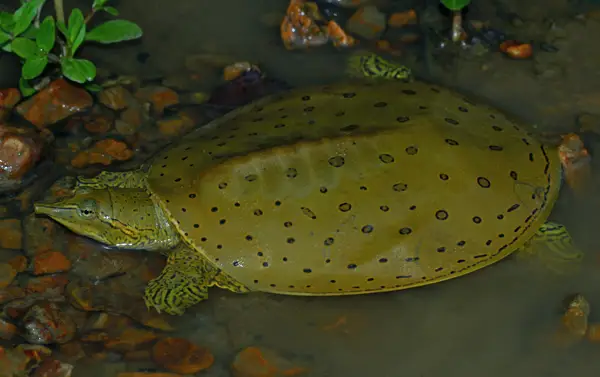
- Scientific name: Apalone spinifera
- Common name: Spiny Softshell Turtle
- Family: Trionychidae
- Size: 5 to 9 inches (males), 12 to 20 inches (females)
- Lifespan: 30 to 70 years
- Conservation status: Least Concern
The Eastern Spiny softshell turtle is a medium-to-large freshwater species that live in states like Michigan, West Virginia, Ohio, Vermont, Tennessee, Missouri, and North Carolina.
This turtle prefers lakes, streams, and rivers with muddy or sandy bottoms and little or no vegetation.
Spiny softshells generally have leathery, pancake-like shells. Both turtle subspecies have shell colors ranging from tan to brown.
The gulf coast has a series of black bars that run around the rim of its shell and ring markings on upper shell. And this distinguishes it from the eastern spiny shell.
Eastern Spiny softshell turtles are mainly carnivorous, and like eating anything, they find in the waters, including crayfish, insects, small fish, and so on.
They hunt by burying themselves in the mud or sand while keeping their head uncovered to grab food as it swims by.
5. Western Spiny Softshell
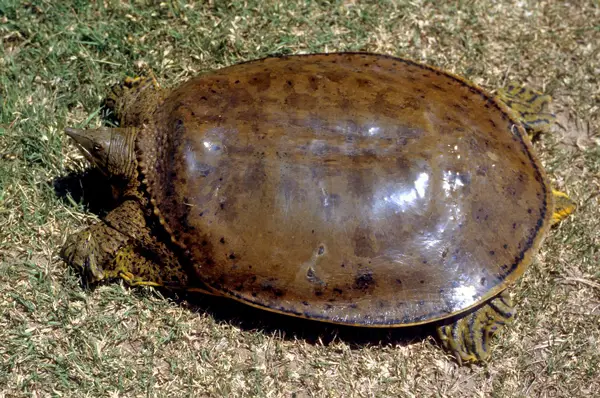
- Scientific name: Alpalone spinifera hartwegi
- Common name: Spiny Softshell Turtle
- Family: Trionychidae
- Size: 5 to 9 inches (males), 12 to 20 inches (females)
- Lifespan: 30 to 70 years
- Conservation status: Least Concern
The Western Spiny softshell turtle is a medium-to-large freshwater species present in Nebraska, Montana, and Arkansas.
The turtle lives in lakes, streams, and rivers with muddy or sandy bottoms and little or no vegetation.
Female spiny softshell turtles are usually larger than males. And unlike other turtles, this species has a flexible, leather-like carapace that’s extremely rounded and flattened.
The shell color can be olive grey or yellow-brown. Just like other softshell turtles, this species also has a snorkel-like snout.
The young ones feature well-defined round spots that are easily visible on the shell (though these spots become invisible as they transition to adulthood).
Spiny softshell turtles tend to eat anything they find in the waters including crayfish, insects, small fish, and so on. They hunt by burying themselves in the mud or sand while keeping their head uncovered to grab food as it swims by.
These turtles are also able to breathe underwater by taking in oxygen through their throat skin. This is a useful adaptation given that they don’t spend a lot of time out of water.
6. Smooth Softshell Turtle
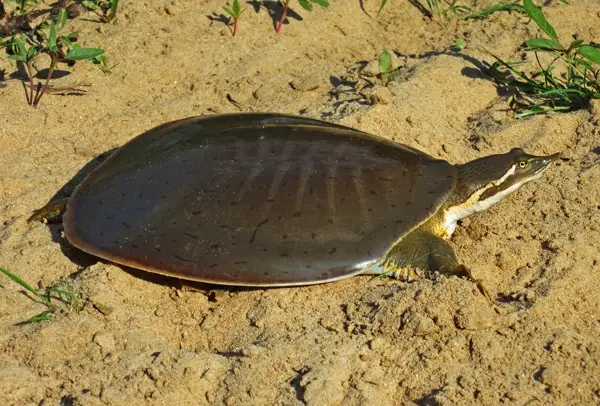
- Scientific name: Apalone mutica
- Common name: Smooth Softshell
- Family: Trionychidae
- Size: 6 to 13 inches
- Lifespan: 40 to 60 years
- Conservation status: Least Concern
The smooth softshell turtle is also found across various states in the US, including North Dakota, Arizona, Indiana, Florida, Illinois, Kansas, Tennessee, Kentucky, Iowa, Louisiana, Minnesota, Missouri, Nebraska, Mississippi, New Mexico, Oklahoma, Ohio, Pennsylvania, South Dakota, West Virginia, Texas, Alabama, and Wisconsin.
There are two species—gulf coast smooth softshell and midland smooth softshell turtle.
The turtles are fast, which enables them to outrun their predators given that their soft shells don’t offer much protection.
Shell color of a smooth softshell turtle species ranges from olive to dark brown. The upper part of its shell features dark markings (with female markings appearing in a blotchier pattern than the males’)
The shell of these turtles also appears rounder and flatter, just like other softshell species.
The main difference existing between the two subspecies is size, with the Gulf coast turtle being the bigger guy (it reaches a maximum of 12 inches long). Also, the Gulf coast species has no lines on its face while the midland smooth softshell turtle does.
These turtles like inhabiting waterbodies like rivers and streams that provide an abundance of mud or sand at the bottom. They can also be found in stagnant waterbodies.
Smooth softshells are omnivorous and their diet revolves around aquatic vegetation and insects. However, they have been observed to like meat more than plant matter and will mainly eat snails, insects, and fish.
Also read: Turtles of Alabama
Painted Turtles:
7. Eastern Painted Turtle
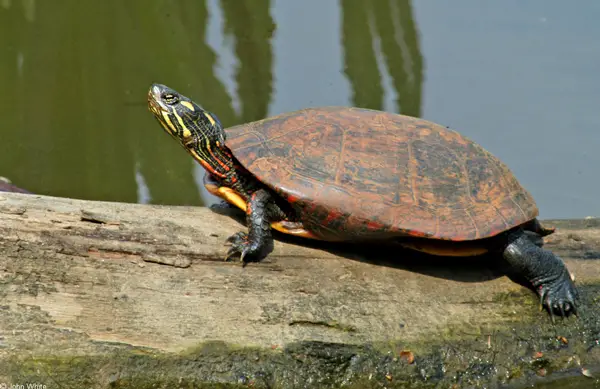
- Scientific name: Chrysemys picta
- Common name: Painted Turtle
- Family: Emydidae
- Size: 4 to 6 inches
- Lifespan: 30 to 50 years
- Conservation status: Least Concern
The Eastern painted turtle is found in West Virginia, Virginia, North Carolina, South Carolina, Rhode Island, Pennsylvania, New Jersey, New York, New Hampshire, Massachusetts, Maine, Maryland, Georgia, Alabama, Connecticut, and Delaware.
It is of the most recognizable turtle species in the US, thanks to its beautiful and unique coloring. The bright reds and yellow-green markings on its shell, head, and limbs are no doubt a beauty to behold!
This painted turtle sub-species has been observed to live near water bodies with minimal movements. Examples include marshes, ponds, slow-moving streams with sandy/muddy bottoms, small lakes, etc.
They also prefer areas with aquatic plants in plenty as they make their primary food source in the wild.
One interesting fact about these turtles is their ability to hold their breath for up to 30 hours when inside temperate water. Moreover, they’re capable of standing dominant in freezing cold waters for up to 4 months.
Unfortunately, it’s not easy to establish the population of these turtles. This is because most people who pet them end up releasing them back into the wild. This contributes to an ever-expanding range plus unstable reproduction rates for these turtles.
8. Western Painted Turtle
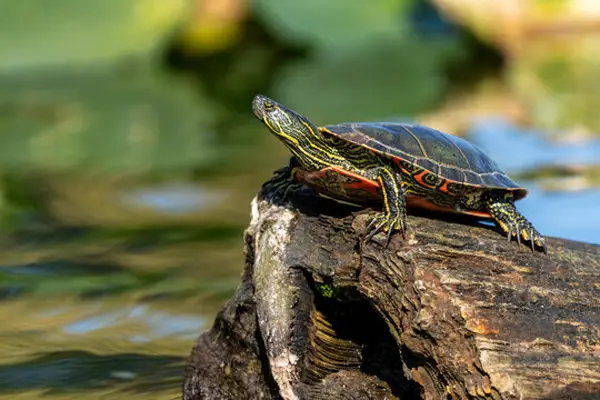
- Scientific name: Chrysemys picta belli
- Common name: Westland Painted Turtle
- Family: Emydidae
- Size: 4 to 10 inches
- Lifespan: 30 to 40 years
- Conservation status: Least Concern
The Western painted turtle is a subspecies of painted turtle found in Idaho, Illinois, Arizona, Arkansas, California, Iowa, Missouri, Kansas, Minnesota, Montana, Oregon, Nebraska, Nevada, Colorado, New Mexico, Oklahoma, North Dakota, South Dakota, Texas, Utah, Washington, Wyoming, and Wisconsin.
This turtle is identified by an oval-shaped carapace that lacks a ridge in the middle. The carapace is usually dark olive or black in color.
The lower side of the shell is usually red, with multiple dark markings in the center. And the skin itself is covered with yellow stripes.
Westland painted turtles are aquatic and their webbed feet help propel them in the waters.
The most common habitats for this turtle include slow-moving rivers, shallow streams, and lakes. They choose these areas because they can easily find food.
Given that they’re omnivorous, they feed on aquatic vegetation as well as meat from insects, snails, shrimps, tadpoles, and earthworms. Their hatchlings are more carnivorous to help take in more proteins for building muscle.
9. Midland Painted Turtle
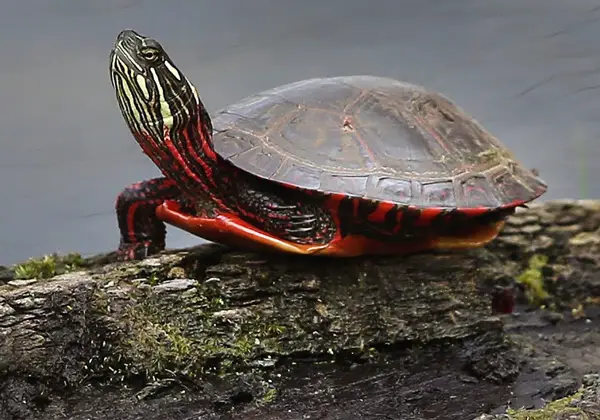
- Scientific name: Chrysemys picta marginata
- Common name: Midland Painted Turtle
- Family: Emydidae
- Size: 4 to 10 inches
- Lifespan: 20 to 40 years
- Conservation status: Least Concern
This is another subspecies of painted turtle you’ll find in Wisconsin, Alabama, Georgia, Pennsylvania, Tennessee, Vermont, Illinois, Maryland, Massachusetts, Michigan, Kentucky, New Hampshire, Ohio, and West Virginia.
Telling this specie apart from other painted turtles can be challenging since it lacks any unique features.
Nonetheless, a typical midland painted turtle has a dark-colored shell and skin that ranges from dark brown to black. Its shell usually features markings on its side, with colors from red to yellow.
The lower side of its shell is usually yellow in color. Don’t forget the skin is usually covered with lines than turn yellowish near the head and then change to red.
Just like the other painted turtles, this species prefers living in freshwater bodies. It can be found in slow-moving rivers, lakes, and ponds.
They’re also omnivorous and like feeding on aquatic vegetation as well as meat from insects, snails, shrimps, tadpoles, and earthworms.
10. Southern Painted Turtle
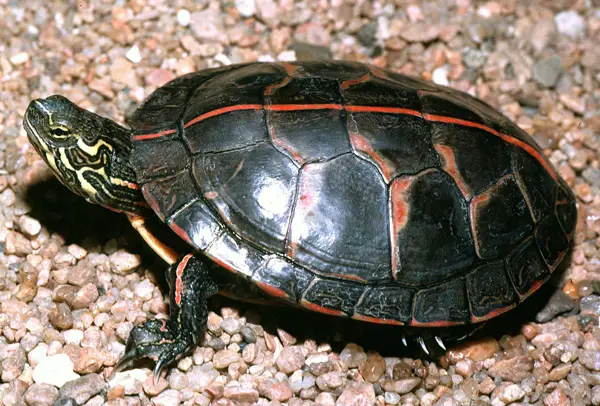
- Scientific name: Chrysemys dorsalis
- Common name: Painted Turtle
- Family: Emydidae
- Size: 4 to 6 inches
- Lifespan: 30 to 50 years
- Conservation status: Least Concern
The Southern painted turtle is a sub-species of painted turtle and the smallest of the painted turtle species in the US. It is present in Alabama, Kentucky, Louisiana, Arkansas, Florida, Georgia, Mississippi, Tennessee, Texas, Missouri, and Oklahoma.
It prefers living in shallow water habits, e.g the edges of lakes and streams.
The average adult size ranges from 4 to 5 inches and is characterized by a distinctive orange or red stripe running down the back of its shell.
They also feature a plain, pale-yellow skin belly (plastron) that’s sometimes lightly spotted.
Baby southern painted turtles tend to eat more meat and less vegetation. And as they grow up, they concentrate more on vegetation and less on animal matter.
Nonetheless, these turtles are omnivorous, just like other species. Some of the most common foods for this species include algae, duckweed, dragonfly larvae, and young crayfish.
Most folks like keeping these turtles as a pet due to their small size and unique color patterns on their shells.
Not to forget, they can live for quite a long time—up to 50 years—and most pet owners end up releasing them back into the wild.
Map Turtles:
11. Northern Map Turtle
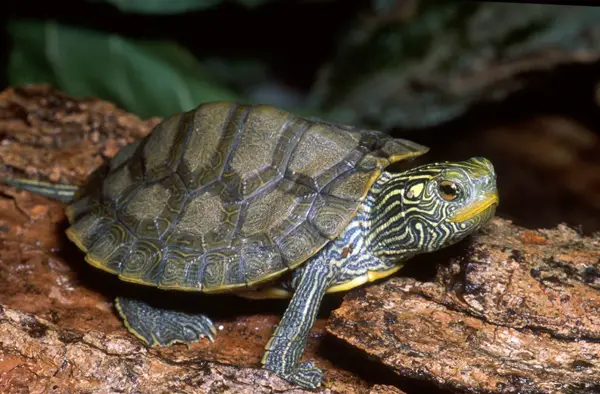
- Scientific name: Graptemys geographica
- Common name: Northern Map Turtle, Common Map Turtle
- Family: Emydidae
- Size: 3 to 10 inches
- Lifespan: 30 to 50 years
- Conservation status: Least Concern
The Northern map turtle is one of the map species that inhabit Maryland, Mississippi, West Virginia, Virginia, Wisconsin, Georgia, Arkansas, Illinois, Kansas, Kentucky, Indiana, Iowa, Alabama, Michigan, Missouri, Minnesota, New Jersey, Oklahoma, Pennsylvania, Tennessee, Vermont, New York, and Ohio.
It prefers large waterbodies with debris. These offer the perfect spots for basking while the water bodies enable the aquatic animal to spend its hibernation periods in winter completely submerged.
Like other map turtles, this common map turtle gets its name from the map-like pattern on its shell. Its shell is typically darker in color and ranges from brown to black. The map pattern has a lighter coloration.
The common map turtle is mainly carnivorous and feeds on mollusks such as clams and snails. It will also eat crayfish and insects. And when animal matter gets scarce, it will turn to plant matter.
Note that it may be difficult to spot a common map turtle in the wild. Although active during the day, these turtles are quite shy and will quickly retreat to the waters at the slightest disturbance.
12. Ouachita Map Turtle
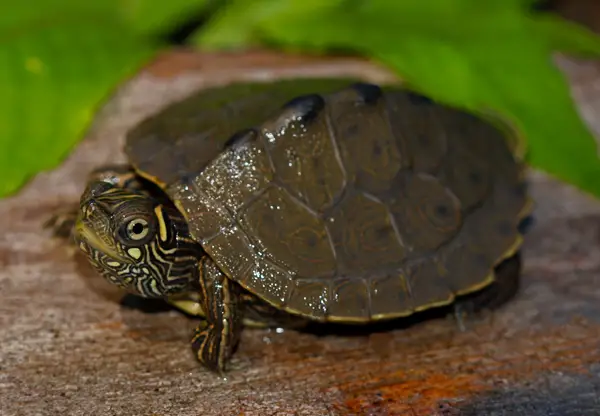
- Scientific name: Graptemys ouachitensis
- Common name: Ouachita Map Turtle, Map Turtle
- Family: Emydidae
- Size: 3 to 5 inches (males), 8 to 10 inches (females)
- Lifespan: 30 to 50 years
- Conservation status: Least Concern
The Ouachita map turtle lives in Wisconsin, West Virginia, Arkansas, Illinois, Alabama, Kansas, Kentucky, Missouri, Ohio, Oklahoma, Tennessee, Minnesota, Mississippi, Louisiana, Iowa, Indiana, and Texas.
As for its name, this species is named after the river where it was discovered—Ouachita!
Ouachita turtle is medium to large in terms of size. The average adult female is 3-5 inches long while the male is 8 to 10 inches long. It features thin, yellowing lines that form a web on the turtle’s shell (similar to a contour elevation map).
Moreover, the turtle has brown to olive coloring, with a light spot under both eyes.
The easiest way to identify this turtle from other map turtle subspecies is by checking the dots on its face. They usually have 3 prominent spots—under the jawline, under the eye, and behind the eye.
Note that this turtle prefers living in stagnant or slow-moving waters, including ponds, lakes, and streams.
It also prefers waters with plenty of vegetation. This species is omnivorous and eats meat, insects, vegetables, fruits, and aquatic vegetation, to name but a few.
13. False Map Turtle
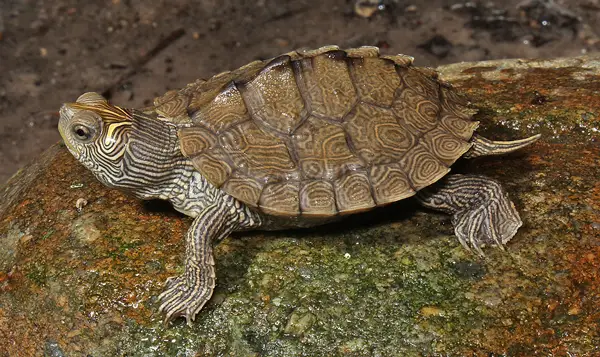
- Scientific name: Graptemys pseudogeographica
- Common name: False Map Turtle, Sawback Turtle
- Family: Emydidae
- Size: 6 to 10 inches (females), 3.5 to 6 inches (males)
- Lifespan: 30 to 50 years
- Conservation status: Least Concern
The False map turtle is another turtle species found in Iowa, Alabama, Florida, Arkansas, Illinois, Kansas, Kentucky, Indiana, Louisiana, Minnesota, Texas, Mississippi, Missouri, Oklahoma, Nebraska, South Dakota, Tennessee, North Dakota, Ohio, and Wisconsin.
This turtle’s preferred habitat includes rivers, streams, oxbow lakes, and river systems. It is an excellent swimmer and prefers moderate currents and deep waters.
Its upper shell coloring ranges from olive to dark brown, with light-colored lines on its limbs. It also features a line behind its eye that forms a backward “L” shape. The map pattern on its carapace tends to fade as the turtle ages.
Since this map turtle is omnivorous, it feeds on aquatic insects and animals as well as vegetation. It is fond of river snails and crustaceans. Don’t forget it has strong jaws and can give a nasty bite!
Like other aquatic turtles, this map turtle spends most of its waking hours sunning.
The false map turtle is quite shy and quietly and swiftly slides into the water at the slightest signs of disturbance. It likes spending most of its time in water and is most active in climate conditions of over 85 degrees Fahrenheit.
14. Barbour’s map turtle
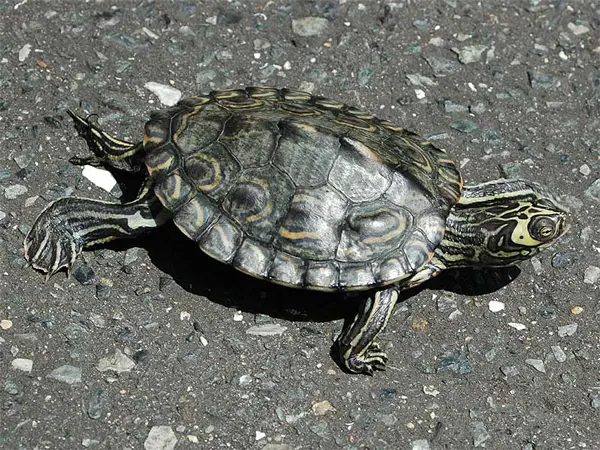
- Scientific name: Graptemys barbouri
- Common name: Barbour Map Turtle, Barbour’s Sawback Turtle
- Family: Emydidae
- Size: 3 to 5 inches (males), 8 to 10 inches (females)
- Lifespan: 30 to 50 years
- Conservation status: Least Concern
The Barbour’s map turtle species is confined to these states: Alabama, Florida, and Georgia.
Since these turtles are highly nervous, you’re cautioned against handling or approaching them if you see them in the wild. When started, they quickly burrow into the bottom of a waterbody or mud.
Barbour’s map turtle has dark brown or black skin covered with yellow to green markings. And on the upper part of their shell lays the spines—their most distinct feature. Though these spines may vary in size from one turtle to another, they all have got dark tips.
Females are usually larger than females. The females’ heads are way larger compared to those of their male counterparts.
The Barbour’s map turtle prefers living in slow-moving or stagnant lakes, ponds, or streams with a lot of aquatic vegetation. It is omnivorous and feeds on insects and aquatic vegetation.
15. Escambia map turtle
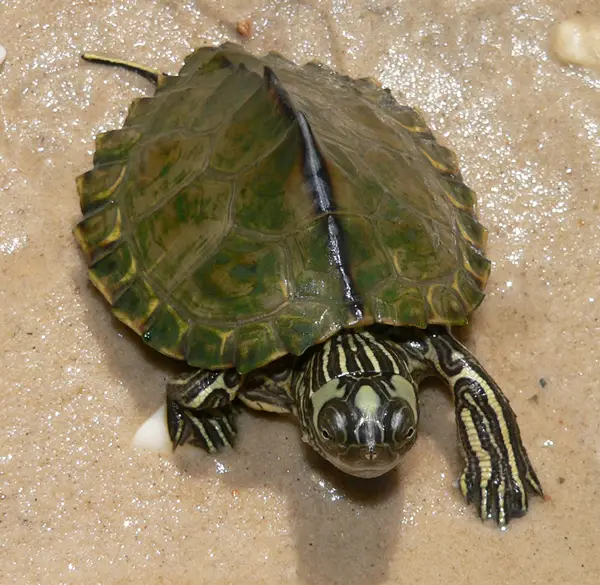
- Scientific name: Graptemys ernsti
- Common name: Map Turtle
- Family: Emydidae
- Size: 3 to 5 inches (males), 8 to 10 inches (females)
- Lifespan: 30 to 50 years
- Conservation status: Least Concern
The Escambia Map Turtle inhabits large rivers in Georgia and Alabama. It gets its name from the fact that it is only found in rivers that drain into Escambia Bay.
This map turtle subspecies has a brown-colored shell with a black pronounced vertebral keel. The skin is usually black and comes covered with white-yellow or white lines. And big white spots can easily be spotted between and behind their eyes.
Like other map turtle sub-species, these turtles also live in slow-moving or stagnant lakes, ponds, or streams with a lot of aquatic vegetation.
They’re omnivorous in nature; males prefer insects and their larvae while females are fond of clams and mussels.
It is also interesting to note that these turtles are closely related to the Barbour’s Map Turtle species. The two species even cross-breed where they have their ranges overlapping.
16. Yellow-blotched map turtle
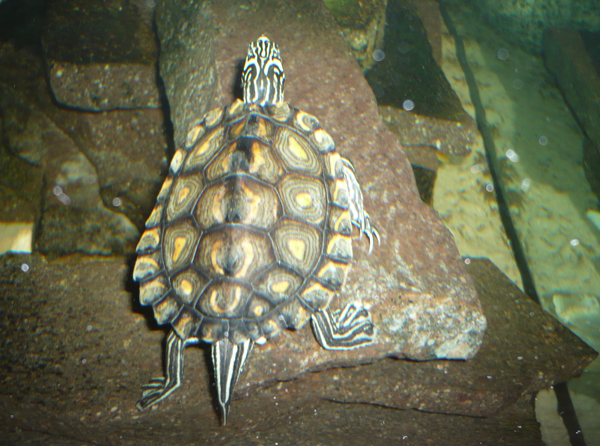
- Scientific name: Graptemys flavimaculata
- Common name: Yellow-blotched Sawback
- Family: Emydidae
- Size: 3.5 to 7.5 inches
- Lifespan: 30 to 50 years
- Conservation status: Endangered
The Yellow-blotched Map Turtle is only found in Mississippi (in Mississippi’s Pascagoula River). It has also been observed in the Escatawpa river.
A Mississippi Yellow-blotched Map Turtle is identified by a green to olive upper shell, with yellow scutes at the center of most of its scutes.
It has a central ridge of prominent keels extending from shell spine. Note that the central keel in this species is the largest that has even been observed in all map turtle species.
Like the other species of map turtles, this Pascagoula map turtle of Mississippi is omnivorous. It mostly feeds on insects, crustaceans, and aquatic plants.
Don’t forget that this turtle is labeled as an endangered species in the US and is under special monitoring.
17. Pascagoula map turtle
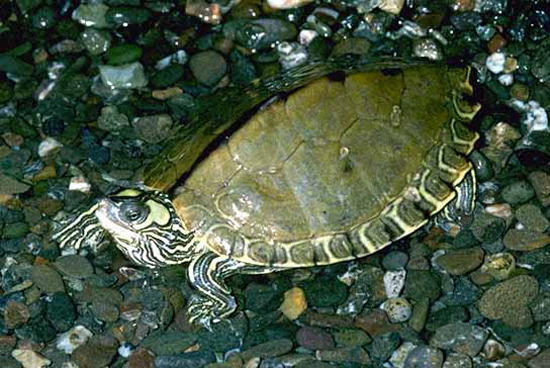
- Scientific name: Graptemys gibbonsi
- Common name: Pascagoula Map Turtle, Pascagoula Sawback
- Family: Emydidae
- Size: 5 to 11.5 inches
- Lifespan: 30 to 50 years
- Conservation status: Endangered
Like the yellow-blotched map turtle above, this map turtle is also found in Mississippi state only.
It is native to the Pascagoula River, situated in Mississippi’s southeastern regions. It gets its name from Whit Gibbons, an American herpetologist.
Due to its restricted habitat, this turtle is classified as endangered and is under special monitoring by the relevant authorities in Mississippi.
The Pascagoula is identified by a brown to olive shell with protruding keels. It also features yellow stripe markings around its scutes, at the edge of the shell. Both its head and skin are olive with yellowish spots and stripes.
Like the other species of map turtles, this Pascagoula map turtle of Mississippi is omnivorous. It mostly feeds on insects, crustaceans, and aquatic plants.
18. Black-knobbed map turtle
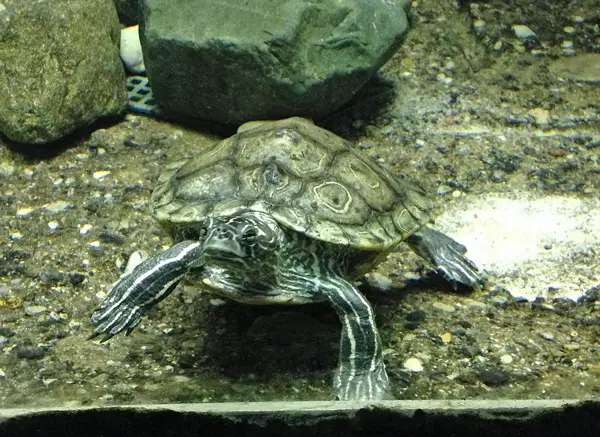
- Scientific name: Graptemys migrinoda
- Common name: Black-knobbed Sawback
- Family: Emydidae
- Size: 3 to 5 inches (males), 8 to 10 inches (females)
- Lifespan: 30 to 50 years
- Conservation status: Least Concern
The black-knobbed map turtle is found in the Mobile Bay drainage system of Alabama and also in Mississippi.
This medium-sized aquatic turtle species is small to medium-sized and is easily identifiable by black knobs/spines along the middle of its back.
In terms of coloration, this species usually has a dark olive upper shell and a pattern that resembles a map, making it a subspecies of map turtles.
And the lower side of its shell features yellow and dark colored patterns. Its skin is usually black with yellow-colored stripes.
Like the other map turtle species, the black-knobbed map turtle prefers living in slow-moving or stagnant lakes, ponds, or streams with a lot of aquatic vegetation.
They’re omnivorous and feed on meat, insects, vegetables, fruits, aquatic vegetation, etc.
19. Ringed map turtle
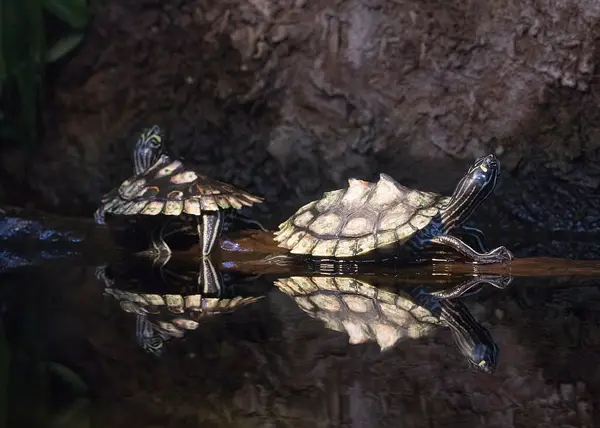
- Scientific name: Graptemys oculifera
- Common name: Ringed Map Turtle, Ringed Sawback
- Family: Emydidae
- Size: 3 to 5 inches (males), 8 to 10 inches (females)
- Lifespan: 30 to 50 years
- Conservation status: Vulnerable
This map turtle shares range with the Pearl River Map Turtles and is found in Pearl River system in Louisiana and Mississippi states.
In the state of Mississippi, this turtle is mainly concentrated in several eastern counties near Pearl River.
You can easily identify a ring map turtle by looking at its shell. It features prominent light circles on a dark shell background—this is where it gets the name “Ringed” turtle.
The shell color ranges from green to yellowish, with some sharp peaks situated down the center. Also, their shells feature jagged, saw-tooth edges.
This ringed map turtle is omnivorous and loves eating crustaceans, mollusks, and aquatic vegetation. It prefers living in moving waters such as rivers.
20. Pearl River Map Turtle
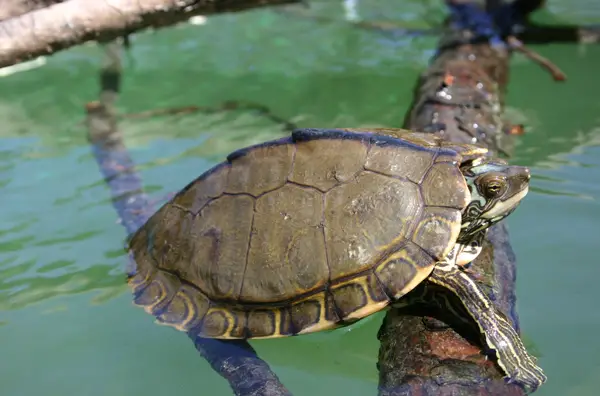
- Scientific name: Graptemys Pearlensis
- Common name: Pearl River Map Turtle
- Family: Emydidae
- Size: 3 to 5 inches (males), 8 to 10 inches (females)
- Lifespan: 30 to 50 years
- Conservation status: Endangered
The Pearl River Map Turtle is native to Pearl River system in Louisiana and Mississippi, hence the name. This rare sub-species of map turtle is native to the Southern United States.
Its upper shell is olive green and features fluted edges with yellow markings. The female usually has a larger head and a flattened, wide beak for crushing food.
Note that it is usually a challenge to tell apart this turtle from some of its close map turtle cousins.
Like the other map turtles, the females are usually larger than the males.
Pearl River Map Turtles are omnivorous and mainly feed on crustacean invertebrates, small fish, and aquatic plants.
Unfortunately, this turtle species is under threat from water pollution and has been labeled as endangered species due to its declining population.
21. Alabama map turtle
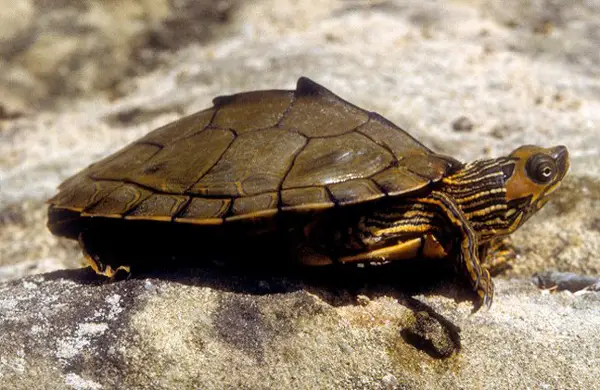
- Scientific name: Graptemys pulchra
- Common name: Alabama Map Turtle, Sawback
- Family: Emydidae
- Size: 3.5 to 5.25 inches (males), 7 to 11.5 inches (females)
- Lifespan: 50+ years
- Conservation status: Near threatened
This species of turtle is found in Mobile Bay Drainage System in Alabama, hence the name Alabama map turtle. It is found in only 3 states namely Alabama, Georgia, and Mississippi.
It is easily identifiable by a spiny black line that runs down the middle of its shell. They get the name “map” from the map-like markings on their shell back.
The Alabama turtles are medium-sized (though males are smaller than females) and are pretty shy. They’re known to slip into the water in case of any disturbance or danger. Their carapace is usually brown with faint yellow, orange, or green markings.
Juveniles are usually bright-colored, but their coloration tends to fade over time. The spiny back of these turtles also tends to wear as they age, especially for adult females.
These Alabama map turtles are omnivorous, and their diet mainly consists of aquatic plants. However, they also feed on insects, small fish, tadpoles, and even worms.
Alabama map turtles are mainly found in shallow and highly vegetated waters, including ponds and rivers. They can also be found in fast-moving creeks featuring rocky bottoms.
22. Cagle’s Map Turtle
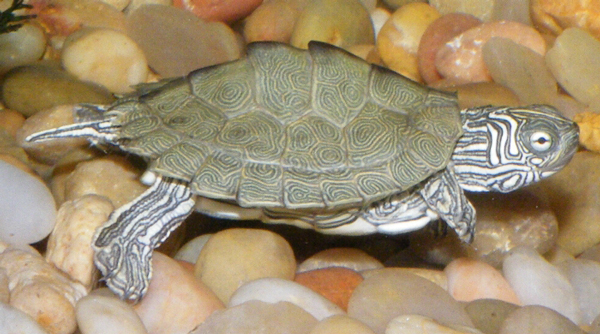
- Scientific name: Graptemys caglei
- Common name: Cagle’s Map Turtle
- Family: Emydidae
- Size: 8 to 10 inches (females), 3 to 5 inches (males)
- Lifespan: 3o to 50 years
- Conservation status: Least Concern
The Cagle’s map turtle is native to Texas. However, it has a pretty small population and is only found in Guadalupe River System in southern Texas.
It gets its name from herpetologist Dr. Fred Ray Cagle. It is somewhat similar to other map turtles in that it has a dark shell with steep keels and serrated rears. It also has cream to yellowish spots on its head.
Cagle’s map turtle of Texas is omnivorous, just like other map turtles. It feeds on mollusks, insects, and (occasionally) vegetation.
This is an endangered species and is under protection by Texas regulations.
Nonetheless, the turtle still finds its way to the pet markets. This is due to its small size, eye-pleasing green coloring and easy to care—these traits are quite rare among the map turtles.
23. Mississippi Map Turtle
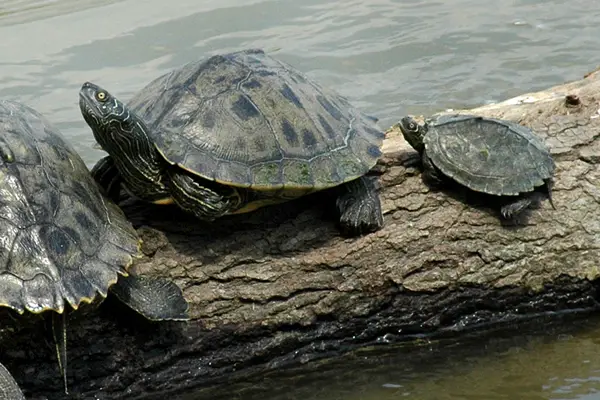
- Scientific name: Graptemys pseudogeographica kohni
- Common name: Mississippi Map Turtle, Sawback turtle
- Family: Emydidae
- Size: 3 to 10 inches
- Lifespan: 30 to 50 years
- Conservation status: Least Concern
The False map turtle is another turtle species found in Mississippi, Iowa, Arkansas, Wisconsin, Tennessee, Minnesota, Missouri, Louisiana, and Kentucky.
This turtle’s preferred habitat includes rivers, streams, and oxbow lakes of the Missouri and Mississippi and other river systems.
It is an excellent swimmer and prefers moderate currents and deep waters.
Its upper shell coloring ranges from olive to dark brown, with light-colored lines on its limbs. It also features a line behind its eye that forms a backward “L” shape. The map pattern on its carapace tends to fade as the turtle ages.
Since this map turtle is omnivorous, it feeds on aquatic insects and animals as well as vegetation. It is fond of river snails and crustaceans. Don’t forget it has strong jaws and can give a nasty bite!
24. Texas Map Turtle
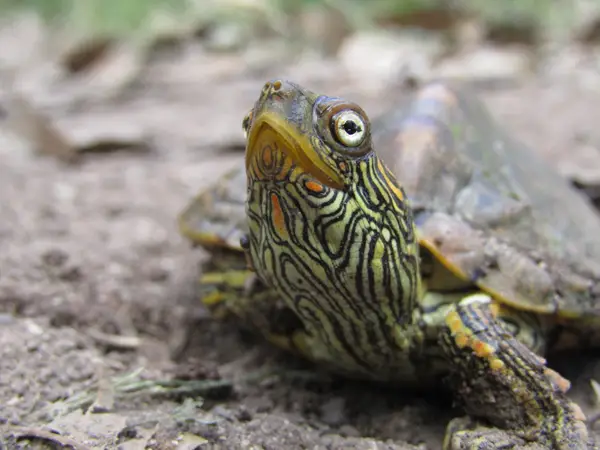
- Scientific name: Graptemys versa
- Common name: Texas Map Turtle
- Family: Emydidae
- Size: 3 to 5 inches
- Lifespan: 3o to 40 years
- Conservation status: Least Concern
This is a relatively smaller subspecies of map turtles endemic to Texas state. It is mainly concentrated in the central regions flanking Colorado river. It can also be found in Concho and Llano river systems.
It prefers living in faster-moving waterbodies. Although it basks regularly, it rarely strays far from the waters. It is an excellent swimmer and even when nesting, it will not go farther than 10 ft. from its pond.
The Texas map turtle’s shell varies from olive to brown and is covered with yellow patterns—just like the contours of a map. Moreover, this turtle has easily visible spiked keels.
A series of 3 yellow to orange spots along the bottom of its head distinguishes this turtle from other map turtle species. The omnivorous turtle feeds on plants, aquatic invertebrates, and insects.
25. Sabine Map Turtle
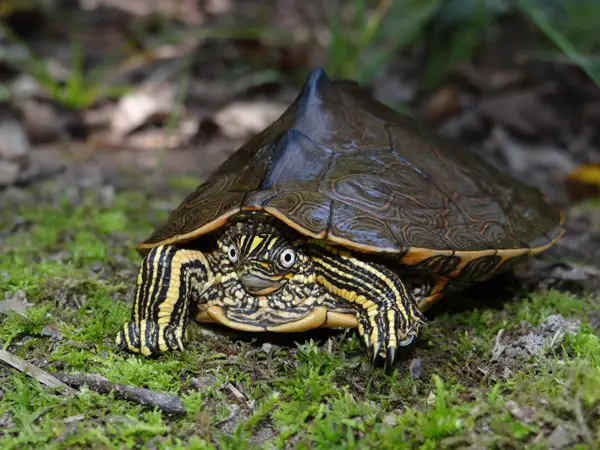
- Scientific name: Graptemys sabinensis
- Common name: Sabine Map Turtle
- Family: Emydidae
- Size: 3 to 5 inches (males), 8 to 10 inches (females)
- Lifespan: 30 to 50 years
- Conservation status: Least Concern
The Sabine Map Turtle inhabits Texas and Louisiana states. It is an extremely close relative of the Ouachita map turtle. They’re quite identical in terms of behavior and looks.
In fact, it has always been considered a sub-species of Ouachita turtle until recently.
The only difference is that this Sabine map turtle has a pretty smaller range and is only found in a few river systems in Texas and Louisiana.
Sabine map turtle has an olive or brown upper shell, with rounded lumps forming a ridge at the center of its back. Black horizontal lines can be seen in its eyes running across white irises.
The face sports yellowish markings while the lower side of its lower shell side has a yellow to cream coloration.
Just like the other map turtles, this Sabine map turtle is omnivorous and feeds on crustaceans, mollusks, small fish, and aquatic plants.
Pond Turtles:
26. Western Pond Turtle
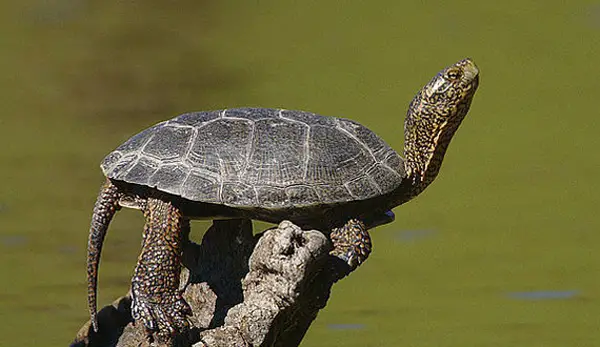
- Scientific name: Actinemys marmorata
- Common name: Western Pond Turtle, Pacific Pond Turtle
- Family: Emydidae
- Size: 6 to 8 inches
- Lifespan: 50 years
- Conservation status: Vulnerable
The Western Pond Turtle is a small-to-medium-sized turtle native to Nevada, Washington, Oregon, and California. It prefers living in creeks, ponds, lakes, and other suitable water bodies.
Carapace coloring for this turtle can be black, brown, or dark green, with some yellowish spots. Patterns of lines or dots also usually radiate from the center of each shell plate of this tortoise.
Also, the limbs of a western pond turtle feature prominent scales while its head is webbed or spotted with black.
Western pond turtle species is omnivorous and its diet includes insects, tadpoles, frogs, and even carrion. For this reason, it prefers living in waterbodies with plenty of aquatic vegetation such as cattails, water lilies, watercress, etc.
The western pond turtle has suffered habitat loss due to development, low reproduction, predators, and invasive aggressive non-native pet turtles being released into the wild. All these factors make the species population greatly endangered.
Pond Sliders:
27. Cumberland slider
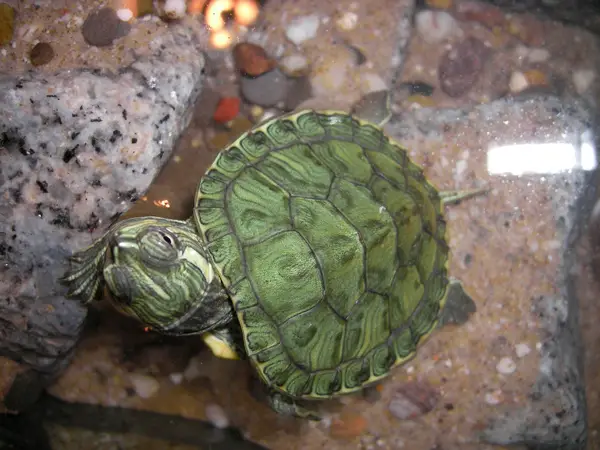
- Scientific name: Trachemys scripta troostii
- Common name: Cumberland turtle, Troost’s turtle
- Family: Emydidae
- Size: 7 to 11 ½ inches
- Lifespan: 40 to 50 years
- Conservation status: Least Concern
The Cumberland is also native to the United States and is present in Virginia, Georgia, and Tennessee.
As a subspecies of pond sliders, this turtle it a close relative of yellow-bellied sliders and red-eared sliders. The turtles are native to the Southeastern United States.
In Tennessee state, they live in the Tennessee and Cumberland river systems.
These medium-sized semi-aquatic turtles’ upper shells range from olive green to brown and feature yellow markings. They also feature yellow stripes behind their eyes.
Lower side of the shell is usually yellow with several black spots. Skin color is usually olive, green, or black, and has multiple yellow stripes.
Cumberland sliders are omnivorous and feed on insects, mollusks, worms, dark leafy land vegetation, and aquatic vegetation.
28. Red-eared slider
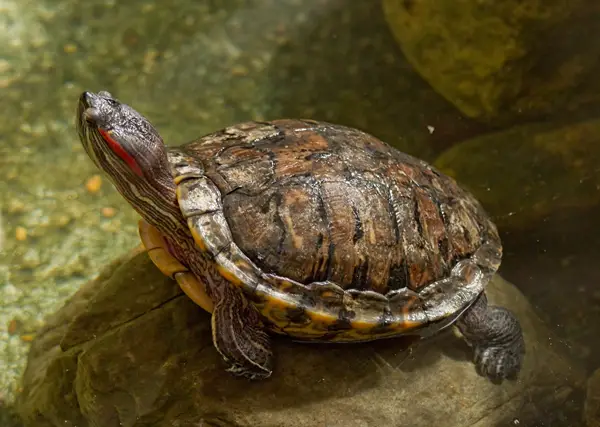
- Scientific name: Trachemys scripta
- Common name: Red-eared Slider, Red-eared Terrapin
- Family: Emydidae
- Size: 7 to 11 inches
- Lifespan: 30 to 40 years
- Conservation status: Least Concern
The red-eared slider is one of the most widespread turtle species in the US. It is present in many states, including Washington, Alabama, Indiana, Iowa, Arkansas, California, Arizona, New Mexico, Delaware, Florida, Kansas, Kentucky, Louisiana, Massachusetts, Michigan, Illinois, North Carolina, Minnesota, Nevada, Mississippi, Nebraska, Missouri, New Jersey, Georgia, Hawaii, Tennessee, Ohio, Oklahoma, Texas, Virginia, Oregon, Maryland, Wyoming, and West Virginia.
It is a semi-aquatic turtle and prefers living in marshes, ponds, lakes, and creeks.
A red-eared slider gets its name from the small red stripe surrounding its ears (or behind the eye), and its ability to quickly slide off logs and rocks into the water.
Generally, the skin and shell coloration of this slider can be brown or black, with yellow stripes covering the skin.
The red-eared sliders are pretty large and the adults reach 7-12 in length (though females are generally larger than males).
These pond sliders are omnivorous and like eating fish, snails, insects, and aquatic vegetation. They also eat land vegetation, including fruits and vegetables.
29. Yellow-bellied slider
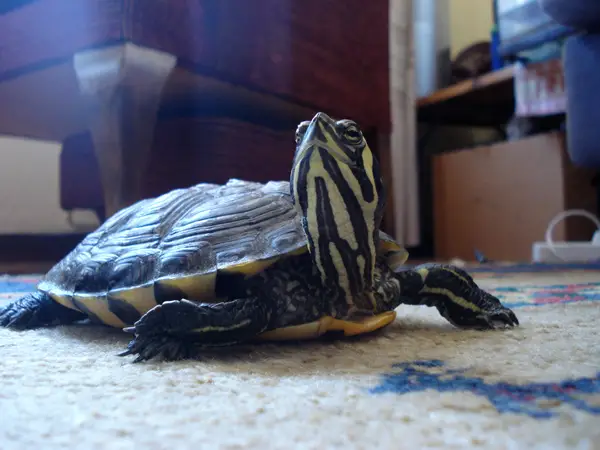
- Scientific name: Trachemys scripta scripta
- Common name: Yellow-bellied slider
- Family: Emydidae
- Size: 8 to 13 inches (females), 5 to 9 inches (males)
- Lifespan: 30 to 40 years
- Conservation status: Least Concern
The yellow-bellied slider turtle is a sub-species of pond sliders native to the Southern region of the United States. It inhabits Mississippi, Tennessee, Virginia, South Carolina North Carolina, Maryland, Kansas, Florida, and Georgia.
It is a semi-aquatic turtle that lives in water as well as land. And it can be found in a variety of habitats including floodplain swamps slow-moving rivers, seasonal wetlands, marshes, and even permanent ponds.
As the name suggests, this turtle features a yellowish plastron. Plus, it bears yellowish markings on its skin, not to forget prominent yellow stripes behind its eyes. The upper shell color ranges from dark brown to olive.
These sliders are omnivorous and like eating fish, snails, insects, and aquatic vegetation. they also eat land vegetation, including fruits and vegetables.
It is also worth noting that yellow-bellied sliders are a popular choice of pet turtles for most folks. They don’t require a lot of special care, which makes them a favorite for many folks.
30. Big Bend Slider
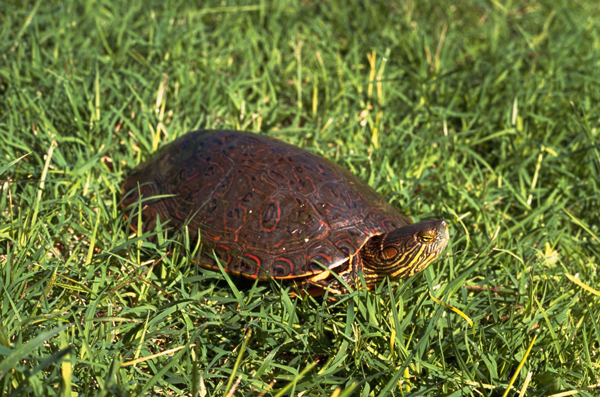
- Scientific name: Trachemys Gaigeae
- Common name: Big Bend Slider, Mexican Plateau Slider
- Family: Emydidae
- Size: 5 to 11 inches
- Lifespan: 20 to 30 years
- Conservation status: Vulnerable
The big bend slider, also known Mexican plateau slider, is another semi-aquatic turtle native to New Mexico and Texas states.
It is pretty close in appearance to its close cousin, the red-eared slider, with the exception that it has fewer red patches around its eyes.
The big bend slider’s upper shell color ranges from olive to dark brown and is covered with a yellow, orange, or red pattern. And the lower side of the shell is yellowish with a few dark spots.
Big bend slider skin color is usually the same as the carapace and is covered in yellow stripes. Two red spots can be easily spotted on each side near its head.
You’ll find this big bend slider in the pond and rivers. The turtle is also fond of basking.
These sliders are mainly herbivorous and like feeding on vegetation as well as fruits, unlike their counterparts (the red-eared sliders) which are omnivorous.
Cooters:
31. River Cooter
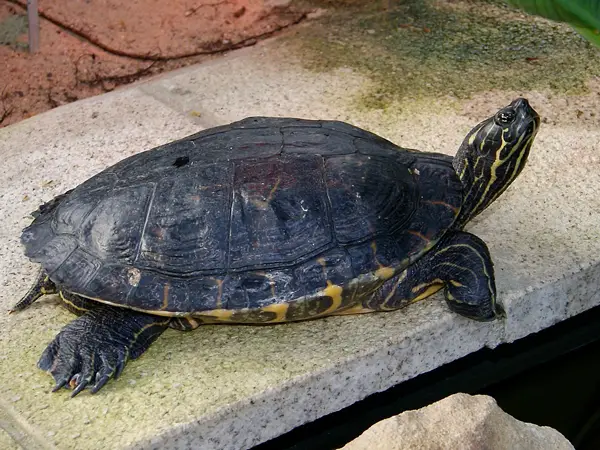
- Scientific name: Pseudemys concinna
- Common name: River Cooter
- Family: Emydidae
- Size: 8 to 12 inches
- Lifespan: 20 to 40 years
- Conservation status: Least Concern
River Cooter turtles are inhabitants of Alabama, Georgia, Florida, Indiana, Kansas, Illinois, Arkansas, Virginia, West Virginia, Kentucky, Missouri, Tennessee, North Carolina, Louisiana, and South Carolina.
They’re known to be solitary creatures and often like basking alone in the sun. However, they can be sometimes observed sharing habitat with painted turtles and red-eared sliders.
They’re distinguishable by their brown to olive or dark-green outer shell and lighter c-shaped, concentric markings in their scutes. Their skin can be olive or olive-brown in color, with numerous yellow lines.
Most of these turtle adults are around 8 to 12 inches in size, though it’s not rare to come across females with a bigger size—up to 15 inches.
These turtles are pretty fast both on land and in water. They’re found in various freshwater bodies including lakes, ponds, and rivers. They’re also found in brackish water.
Their diet is primarily herbivorous and mainly consists of various forms of aquatic vegetation and land plant matter, including fruits and vegetables. They’re however known to occasionally feed on insects and snails.
32. Coastal Plain Cooter
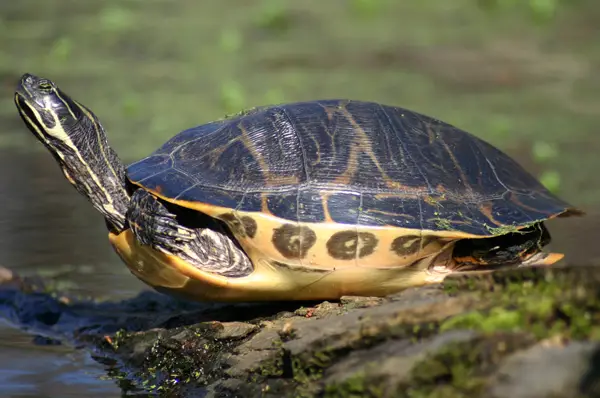
- Scientific name: Pseudemys floridana
- Common name: Florida Cooter, Coastal Plain Cooter
- Family: Emydidae
- Size: 8 to 12 inches
- Lifespan: 20 to 40 years
- Conservation status: Least Concern
The Florida Cooter is one of the largest turtle species inhabiting Alabama, Virginia, Florida, South Carolina, and North Carolina.
The average adult size is 8 to 12 inches long (with the record length being 16 inches!).
This Cooter features an upper shell that’s colored brown to olive green, sometimes it can be dark green. On top of this, the feature light vertical stripes on its outer shell—this is the distinctive feature separating it from its cousins.
Florida cotter species like living in marshes, rivers, swamps, or lakes.
They tend to get pretty nervous, so it’s best to observe them and not handle or suddenly approach them, especially when in the wild. Otherwise, they can feel intimidated and stressed and retreat back to the waters.
They’re primarily herbivorous and are often observed feeding on fruits, veggies, and various other forms of aquatic vegetation.
However, they aren’t 100% herbivorous and can be seen feeding on insects and snails if they’re easily caught or if they’re abundant.
33. Northern Red-Bellied Cooter
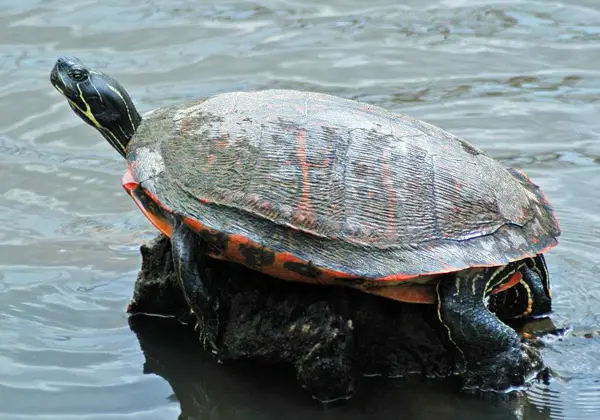
- Scientific name: Pseudemys rubriventris
- Common name: Northern Red-Bellied Turtle,American red-bellied turtle
- Family: Emydidae
- Size: 10 to 12 inches
- Lifespan: 40 to 60 years
- Conservation status: Not Threatened
The Northern redbelly Cooter is present in New York, West Virginia, New Jersey, Virginia, Maryland, Delaware, Massachusetts, Pennsylvania, and North Carolina.
As you can tell from its name, this species features a completely red (vibrant) plastron, sometimes covered with green spots. The turtle is known to live in freshwater streams, ponds, and lakes.
And when the conditions allow, the turtle will venture into brackish streams near the coast.
A redbelly Cooter differs from other turtles with its head pattern which has lighter markings forming a distinct arrow shape, pointing toward the snout. The upper shell ranges form from dark brown to black.
Northern redbelly turtles are mainly herbivorous, and will mostly feed on aquatic plants.
Note that this turtle species faces many threats including wetland loss, habitat loss, pollution, and collection for selling as pets.
At some point, this turtle was even sold for consumption (some countries still consume it even today!)
34. Rio Grande Cooter
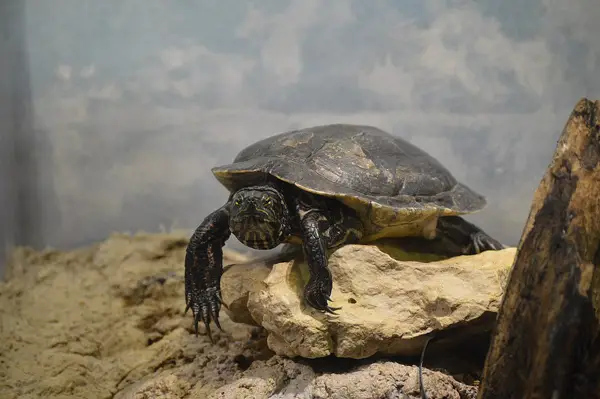
- Scientific name: Pseudemys Gorzugi
- Common name: Western River Cooter, Rio Grande River Cooter
- Family: Emydidae
- Size: 8 to 12 inches
- Lifespan: 20 to 40 years
- Conservation status: Near Threatened
The Rio Grande Cooter is a semi-aquatic turtle that inhabits Texas and New Mexico.
It is mainly found in larger ponds and rivers with decent depths. It gets its name from the Rio Grande river in New Mexico and Texas, where it was first spotted.
This Cooter is easily identified by its shell which is usually olive green or dark brown, or even black. Its rearward scutes also appear slightly jagged.
Swirling patterns of red, orange, or yellow lines can also be seen. As for the plastron, it’s usually yellowish or reddish.
A Rio Grande Cooter is usually omnivorous and prefers feeding on plants and vegetation. On an occasional basis, however, it can be seen eating mollusks or invertebrates.
Unfortunately, the population of this Cooter continues to go downward due to pollution as well as water diversion projects. This explains why it is classified as near threatened.
35. Alabama red-bellied Cooter
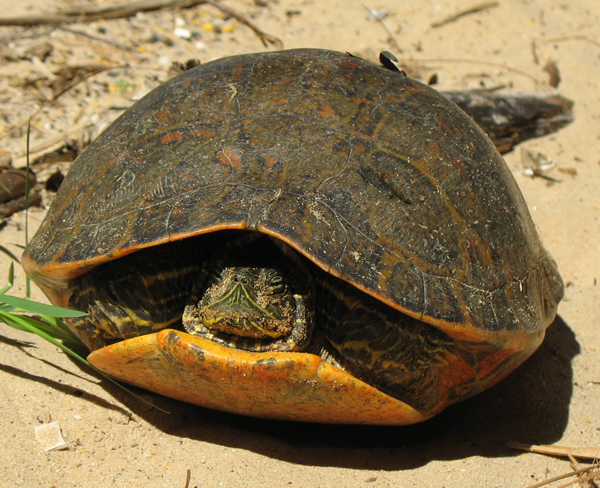
- Scientific name: Pseudemys alabamensis
- Common name: Alabama red-bellied turtle, Red-belly, Slider, Cooter
- Family: Emydidae
- Size: 8 to 12 inches
- Lifespan: 40 to 60 years
- Conservation status: Not Threatened
Alabama red-belly Cooter lives in the fresh, shallow waters of Alabama and Mississippi states. However, it’s not uncommon to come across one in slightly brackish waters.
These turtles are average-sized compared to most species and can reach between 8 and 12 inches in length.
The redbelly scooter usually has a dark brown shell color, with some orange or red coloring on its edges. The lower side of the shell is usually red or orange. The turtle’s skin is usually black or dark brown and is covered by orange or yellow stripes.
Young Alabama red-bellied turtles have more intense and bright coloring, but it fades as they age.
The turtles are, mainly herbivorous and fed on aquatic plants, algae, and land vegetation (they feed on this when basking or nesting). Mind you, this turtle is much easier to find when it’s foraging.
Alabama redbelly turtles are quite nervous and like basking on logs in the sun. They quickly retreat back into the water if they feel threatened or disturbed.
36. Peninsula Cooter
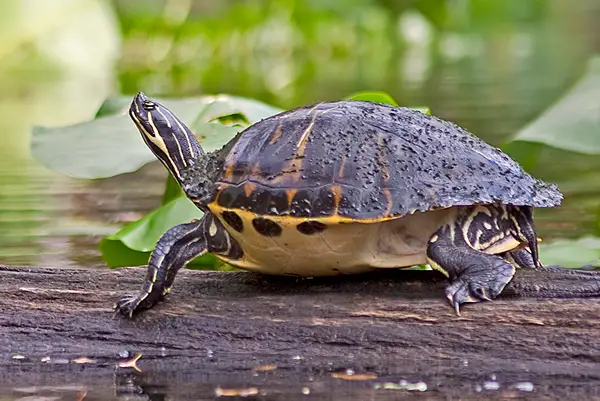
- Scientific name: Pseudemys peninsularis
- Common name: Peninsula Cooter
- Family: Emydidae
- Size: 9 to 13 inches
- Lifespan: 30 years
- Conservation status: Least Concern
The Peninsula Cooter is a freshwater turtle species endemic to Florida state.
It is a medium-sized species featuring a dark-colored upper shell with yellow or orange patterns. It has a lighter plastron compared to the Florida red-bellied Cooter.
Its preferred habitat is in the canals and lakes in Florida, and can sometimes be spotted in the Everglades.
This native Florida Cooter is a close relative to the coastal plain Cooter and some scientists even consider it a sub-species.
Remember that telling apart this Cooter from other Cooter species may be challenging due to how similar it is in physical appearance.
The thin, light lines on the head and top shell (also known as hairpins), are a good clue that you are looking at the Peninsula Cooter!
37. Hieroglyphic River Cooter
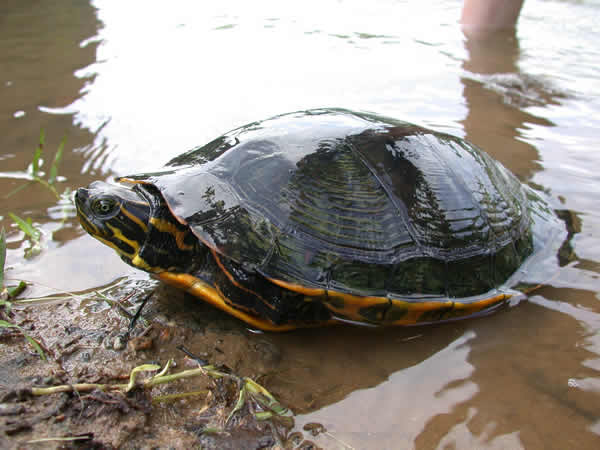
- Scientific name: Pseudemys concinna hieroglyphica
- Common name: River Cooter
- Family: Emydidae
- Size: 8 to 12 inches
- Lifespan: 20 to 40 years
- Conservation status: Least Concern
River Cooter turtles are inhabitants of Tennessee and Indiana.
They’re known to be solitary creatures and often like basking alone in the sun.
However, they can be sometimes observed sharing habitat with painted turtles and red-eared sliders.
They’re distinguishable by their green-brown or black carapace with red or orange patterns resembling hieroglyphics. Their plastron is light colored while the skin is covered with pronounced stripes ranging in color from yellow to orange or red.
Most of these turtle adults are around 8 to 12 inches in size, though it’s not rare to come across females with a bigger size—up to 15 inches.
These turtles are pretty fast both on land and in water. They’re found in various freshwater bodies including lakes, ponds, and rivers. They’re also found in brackish water.
Their diet is primarily herbivorous and mainly consists of various forms of aquatic vegetation and land plant matter. They also occasionally feed on insects and snails.
Terrapins:
38. Diamondback terrapin
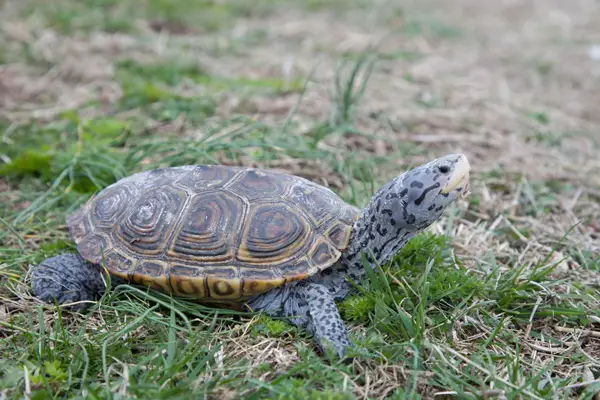
- Scientific name: Malaclemys terrapin
- Common name: Diamondback Terrapin
- Family: Emydidae
- Size: 4 to 6 inches (males), 5 to 8 inches (females)
- Lifespan: 25 to 35 years
- Conservation status: Vulnerable
The diamondback terrapin is found in New Jersey, Alabama, Connecticut, Rhode Island, Delaware, Georgia, Florida, Louisiana, Maryland, Mississippi, New York, Texas, South Carolina, North Carolina, Massachusetts, and Virginia.
It is the only freshwater turtle that can adapt to saltwater as well. Their shells have a raised diamond shape, hence the name diamondback. The term “terrapin” simply means little turtle.
A typical diamondback terrapin has a black-to-brown carapace and yellow lower shell that may sometimes feature dark-colored patterns. The turtle’s skin is usually grey-white with multiple small black spots.
Female diamondback terrapins are usually bigger than their male counterparts.
These turtles are highly timid and can easily get stressed when in captivity. They’re pretty docile and can be handled. However, they’re known to bite as a way of defending themselves if they feel threatened.
Diamondback terrapins can be found along the coast in tidal flats, salt marshes, barrier beaches, and brackish streams. They can also stay in full-strength saltwater for longer periods of time.
The terrapins are largely carnivorous and feed on crustaceans, fish, crabs, shrimps, marine snails, marine worms, mollusks, mussels, clams, and barnacles. However, they also tend to occasionally ingest small amounts of plant matter.
Mud Turtles:
39. Mississippi Mud Turtle
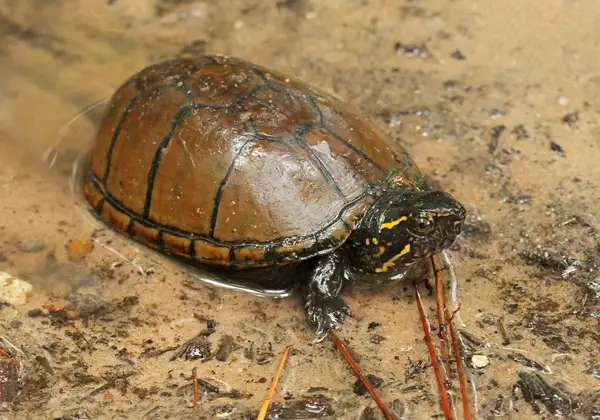
- Scientific name: Kinosternon subrubrum
- Common name: Eastern Mud Turtle, Mud Turtle
- Family: Kinosternidae
- Size: 3 to 5 inches
- Lifespan: 50 years
- Conservation status: Least Concern
The Mississippi Mud turtle inhabits Mississippi, Louisiana, Georgia, Oklahoma, and Arkansas. It prefers living in shallow waters including ditches, marshes, wet meadows, and swamps.
This smaller aquatic turtle species is characterized by a smooth and unmarked shell. Yes, it has an incredible plain look, with its upper shell lacking any patterns. The carapace color ranges from dark yellow to black.
The lower side of the shell is also pretty plain, though it usually appears lighter on the upper part. The key distinction of this mud turtle is the stripes on its head which can be white or yellow in color.
One particular feature that sets this turtle apart from others and makes it easily identifiable is the hinges on its lower shell which form a “K” shape when viewed from the sides.
Just as its name suggests, this turtle lives in water bodies with a soft muddy, or sandy bottom. Thus, they can be found in marshes, swamps, and rivers.
Since this mud turtle is omnivorous, it eats meat, fish, snails, insects, and aquatic vegetation as well as plant matter on land.
Unlike other turtles, eastern mud turtles do not hibernate in the cold winter months. Instead, it does the opposite—it becomes dormant in the hot months of summer (this is known as aestivation).
40. Yellow mud turtle
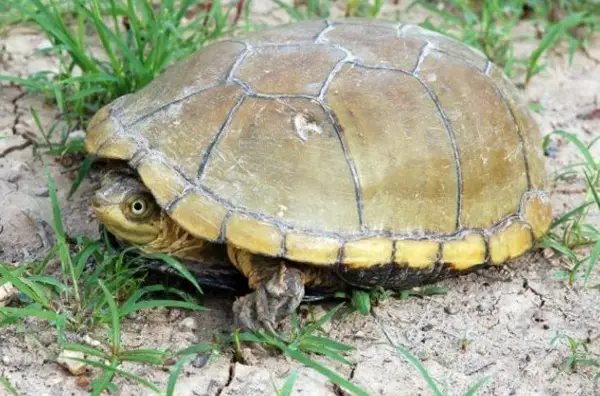
- Scientific name: Kinosternon arizonense
- Common name: Yellow Mud Turtle, Mud Turtle
- Family: Kinosternidae
- Size: 4-5 inches
- Lifespan: 40 years
- Conservation status: Least concern
The Yellow mud turtle is a species native to these states: Arkansas, Arizona, Colorado, Iowa, Kansas, New Mexico, Oklahoma, Illinois, Missouri, Nebraska, and Texas.
Potential habitats for this turtle include muddy pools, cattle tanks, irrigation ditches, sewer drains, and even cisterns!
This turtle will spend more time on land migrating to new water sources and is never picky about where it can stay.
It has its upper shell part flattened with colors varying from brown to black or olive. It also features dark brown edges around its scutes. The skin color is usually olive. Males have a sharp or horny end as a distinctive feature.
This yellow mud turtle is omnivorous like any other mud turtle. its diet is made up of a variety of foods including tadpoles, leeches, crayfish, fairy shrimp, and fish.
It will also eat frogs, slugs, and snails. And as an opportunistic feeder, it will also eat decaying animal and plant matter.
41. Sonora mud turtle
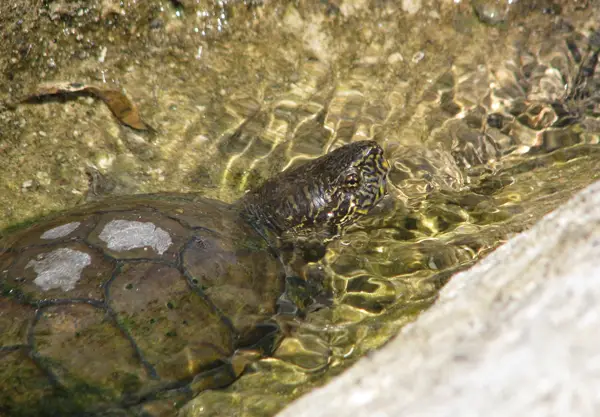
- Scientific name: Kinosternon sonoriense
- Common name: Sonora Mud Turtle, Mud Turtle
- Family: Kinosternidae
- Size: 5 to 7 inches
- Lifespan: 30 to 50 years
- Conservation status: Near threatened
The Sonoran mud turtle is pretty isolated and won’t be found in many areas apart from Arizona, Mexico, and New Mexico.
This turtle likes spending most of its time in water and is fond of creeks, streams, and even stock ponds in
A Sonora mud turtle is identified by its brown skin with yellow lines. The upper shell is olive-brown in color and has keels on it.
Similar to most other mud turtles, these turtles are omnivorous and like feeding on small insects and animals as well as vegetation.
Although this turtle species was once widespread, its range and population have been on the decline owing to habitat loss due to human intervention.
For this reason, the Sonora mud turtle has been labeled a “Near Threatened” species and is under special protection.
42. Eastern Mud Turtle
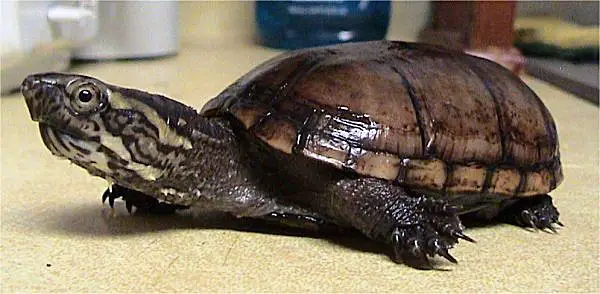
- Scientific name: Kinosternon subrubrum
- Common name: Eastern Mud Turtle, Mud Turtle
- Family: Kinosternidae
- Size: 3 to 5 inches
- Lifespan: 50 years
- Conservation status: Least Concern
The Eastern Mud turtle is present in Alabama, Arkansas, Mississippi, Georgia, Louisiana, and Oklahoma.
It is commonly found in shallow waters including ditches, marshes, wet meadows, and swamps.
This smaller aquatic turtle species is characterized by a smooth and unmarked shell. It has an incredible plain look, with its upper shell lacking any patterns. The carapace color ranges from dark yellow to black.
The lower side of the shell is also pretty plain, though it usually appears lighter on the upper part. The key distinction of this mud turtle is the stripes on its head which can be white or yellow in color.
One particular feature that sets this turtle apart from others and makes it easily identifiable is the hinges on its lower shell which form a “K” shape when viewed from the sides.
Just as its name suggests, this turtle lives in water bodies with a soft muddy, or sandy bottom. Thus, they can be found in marshes, swamps, and rivers.
Since the eastern mud turtle is omnivorous, it eats meat, fish, snails, insects, and aquatic vegetation as well as plant matter on land.
Unlike other turtles, eastern mud turtles do not hibernate in the cold winter months. Instead, it does the opposite—it becomes dormant in the hot months of summer (this is known as aestivation).
43. Striped mud turtle
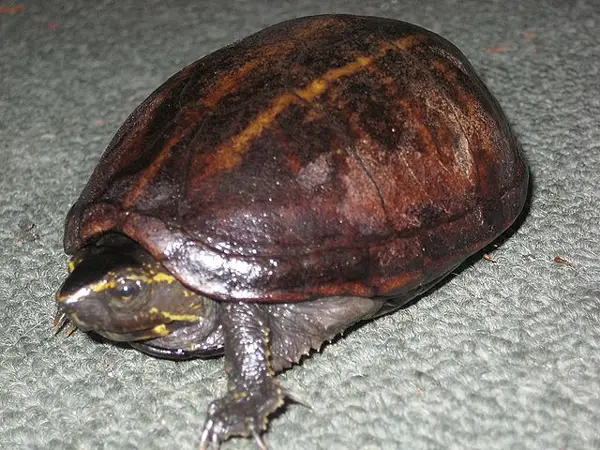
- Scientific name: Kinosternon baurii
- Common name: Striped Mud Turtle, Three-Striped Mud turtle
- Family: Kinosternidae
- Size: 4 to 5 inches
- Lifespan: 15 to 20 years
- Conservation status: Least Concern
The striped mud turtle is widespread throughout various US states including Florida, Tennessee, Georgia, North Carolina, Virginia, South Carolina, and Maryland.
You’ll most likely see them in the cypress swamps, ditches, and drainage canals.
Striped mud turtles usually have dark-brown oval-shaped shells, with 3 yellowish vertical stripes (hence their name).
The turtle species are quite easy to spot than other mud turtles as they spend more time on land than in water. They are unlike other mud turtles in that they sun themselves, forage for insects, and like resting out of the waters.
This mud turtle is omnivorous and eats snails, insects, fish, algae, carrion, and even plants. The turtle has also been observed eating dried krill.
Note that this turtle species is considered an imperiled species. Nonetheless, this small aquatic species is no longer considered under the status of Federal Endangered Status.
44. Rough-footed mud turtle
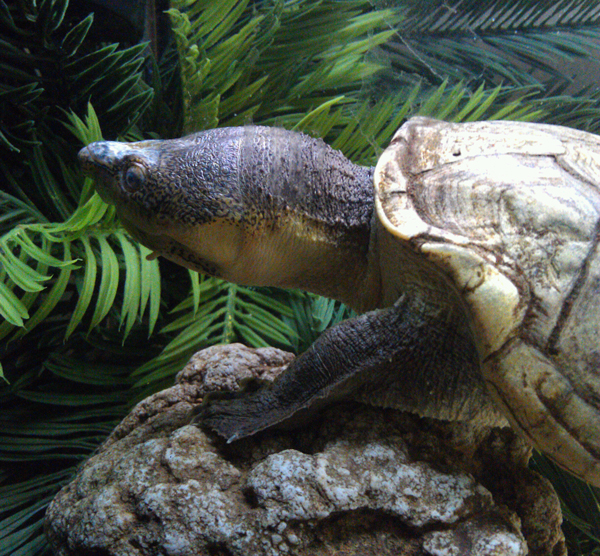
- Scientific name: Kinosternon hirtipes
- Other common names: Chihuahuan Mud turtle, Big Bend Mud turtle
- Family: Kinosternidae
- Size: 5 and 7 inches
- Lifespan: 30 to 50 years
- Conservation status: Least Concern
The rough-footed mud turtle is native to Texas and is pretty rare in this state. It is only found in southwestern areas, around the region of Big Bend (hence, it’s also known as the big bend mud turtle).
This mud turtle sports a domed shell ranging from olive to yellowish-brown. Its plastron and skin share the same color, so they easily blend in.
Just like other mud turtle species, this turtle has short and fleshy barbells that protrude from its chin and throat.
The big bend mud turtle of Texas is omnivorous and likes easting mollusks, small fish, invertebrates, and vegetation.
It prefers living in shallow waters where it can easily burrow into the sand or even silt at the bottom.
Musk Turtles:
45. Common Musk Turtle
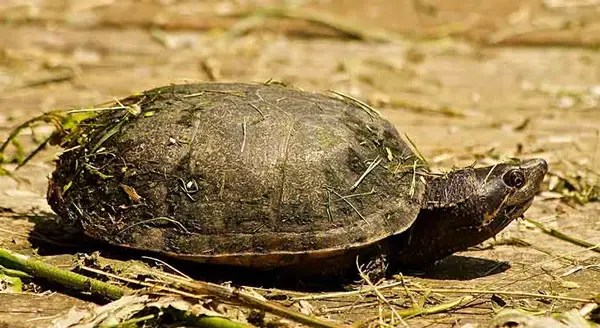
- Scientific name: Sternotherus odoratus
- Common name: Eastern Musk Turtle, Common Musk Turtle, Musk Turtle, Stinkpot
- Family: Kinosternidae
- Size: 2 to 4.5 inches
- Lifespan: 30 to 50 years
- Conservation status: Least Concern
The Common Musk Turtle is present in multiple regions of the US including Minnesota, Mississippi, Alabama, Iowa, Kansas, Arkansas, Connecticut, Illinois, Indiana, Kentucky, Louisiana, Massachusetts, Maine, Maryland, New Jersey, Michigan, Texas, Missouri, New Hampshire, New York, Ohio, Oklahoma, Pennsylvania, Delaware, Florida, South Carolina, North Carolina, Tennessee, Vermont, Rhode Island, Virginia, West Virginia, Georgia, and Wisconsin.
It is usually found in slow-moving and sluggish streams as well as still water bodies. The turtle prefers areas with dark crevices, where it can easily hide. It also prefers lots of plant matter to burrow in and hide.
An average adult eastern musk turtle is quite small (2 to 4.5 inches long). It has a pretty plain appearance with highly consistent colors. Both the shell and skin usually share the same color and can range from dark brown to black.
The turtle shell has one unique feature—a ridge traversing its entire shell length. Besides, it has another distinctive feature: two light-colored stripes on its head.
Common musk turtles are herbivorous and will eat small aquatic or semi-aquatic animals, carrion, and aquatic vegetation. They will also feed on any other vegetation on land.
When it feels threatened, this turtle species emits a foul odor (a musky odor, hence its name). This scent can be detected in water or on land. It can also easily waft through the air to its predators.
46. Loggerhead musk turtle
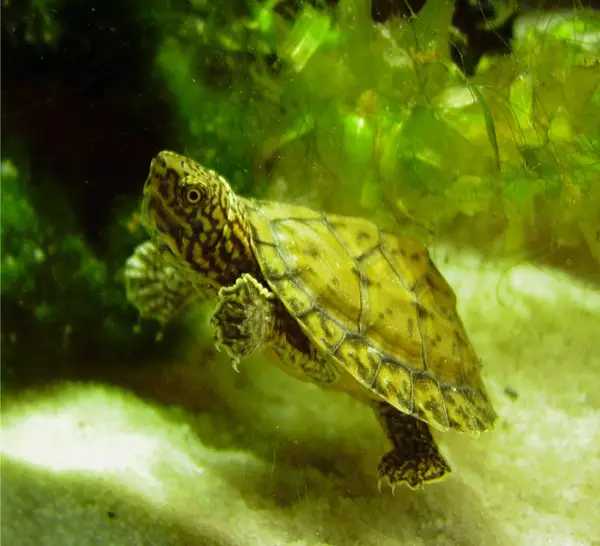
- Scientific name: Sternotherus minor
- Common name: Stripe head or loggerhead turtle
- Family: Kinosternidae
- Size: 3 to 4 inches
- Lifespan: 20 to 40 years
- Conservation status: Least Concern
The loggerhead musk turtle inhabits North Carolina, Alabama, Florida, Mississippi, Virginia, Tennessee, Louisiana, and Kentucky.
It is the most recognizable of all the musk turtles, thanks to its large head and a beak-like mouth that easily set it apart from many other species of turtles.
These turtles are among the smallest of the species in the US, with the adult hitting a maximum length of 3 to 4 inches.
Also, the loggerhead turtle features quite pronounced scutes in the middle of its shell which become less and less visible as it ages.
Their carapace is usually light brown with a small streak of black. And their lower shell side is light brown or yellow. The skin color is black, with light brown lines.
As for the habitat, these turtles prefer streams and springs with muddy bottoms, where they can comfortably and safely rest or lay eggs.
Loggerhead musk turtles are mainly carnivorous and their diet consists of fish, snails, and mollusks. When approached by predators, these turtles will also produce a foul smell.
47. Flattened musk turtle
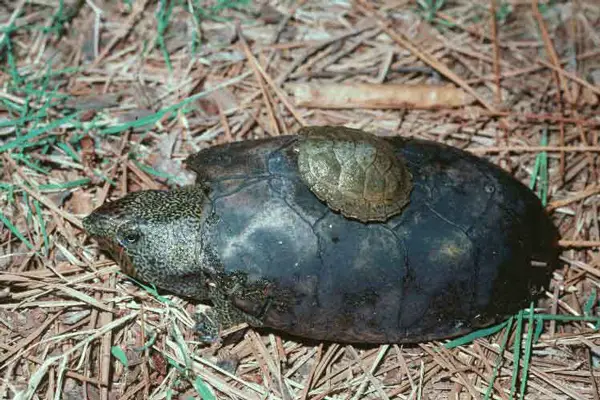
- Scientific name: Sternotherus depressus
- Common name: Musk Turtle
- Family: Kinosternidae
- Size: 3 to 4 inches
- Lifespan: 50 to 60 years
- Conservation status: Critically Endangered
The flattened musk turtle is ONLY found in Alabama. To be more precise, it lives in the Black Warrior river system, located in west-central Alabama.
This turtle species is quite small (3 to 4 inches long) and differs from other turtles with its carapace shape that’s flat on top, with rounded edges. The scutes on its carapace slightly overlap to give the shell a ridged look.
Flattened musk turtles usually have a dark brown carapace while the lower side of the shell is lighter brown. The skin can be black or dark brown, with numerous olive spots.
The musk turtle species love to eat aquatic insects and mollusks and live in freshwater lakes and rivers.
One interesting fact about these turtles is that they’re believed to have evolved over 15 million years ago before the dinosaurs became extinct.
Flattened musk turtles are protected given that 90% of their habitat has been destroyed as a result of erosion caused by strip mining in their habitat.
48. Razor-backed Musk Turtle
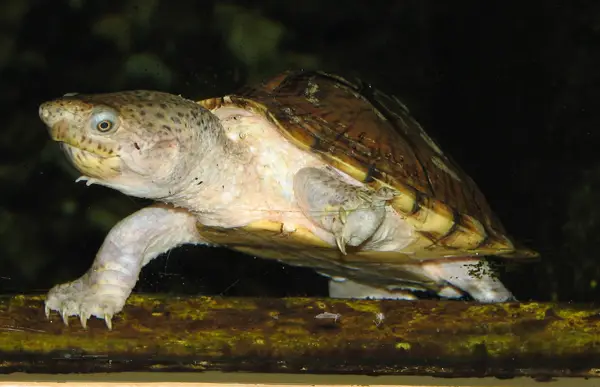
- Scientific name: Sternotherus carinatus
- Common name: Musk turtle, stinkpot
- Family: Kinosternidae
- Size: 5 to 6 inches
- Lifespan: 40 to 50 years
- Conservation status: Least Concern
The razor-backed must turtle has been found in Alabama, Mississippi, Texas, Arkansas, Louisiana, and Oklahoma.
It is identified by the keels on its back. In other words, its carapace is shaped like a tent that comes to a point along its spine and then slopes down on its sides.
Just like the other must turtles, this species is also pretty small and the average adult hits 5-6 inches in length. Their shell color ranges from light grey to olive, brown, and black.
Skin color can be olive or dark brown, though the exact color differs from individual to individual.
These turtles usually have long necks and large heads which usually have bright colors and turn gray with dark spots as they age.
This razor-back musk turtle prefers living in water almost entirely and will only leave the waters to bask or when it’s time to lay eggs. The species live in deep waters of oxbow lakes and river swamps. They also prefer living in slow-current large streams.
Diet-wise, the razor-back musk turtle is mainly carnivorous and is fond of mollusks, snails, and fish.
49. Stripe Neck Musk Turtle
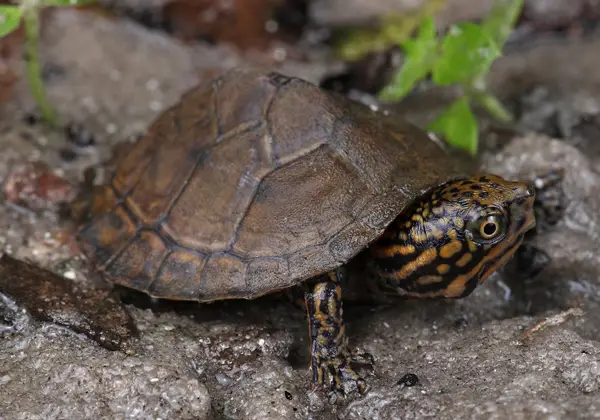
- Scientific name: Sternotherus minor peltifer
- Common name: Stripe-necked Musk Turtle
- Family: Kinosternidae
- Size: 3 to 4.5 inches
- Lifespan: 20 to 50 years
- Conservation status: Vulnerable
The Striped-necked musk turtle is a subspecies of loggerhead musk turtle that lives in Tennessee, North Carolina, and Virginia.
This small aquatic turtle has a larger head compared to other musk turtles. It is highly aquatic and likes living in streams as well as rivers in the mountains.
The most distinguishable feature of this musk turtle is the numerous dark stripes that line its neck and head. its carapace is keeled and is gray or brown in color.
The carapace may sometimes feature dark spots or streaks. Its plastron is yellow and unspotted.
In terms of diet, this turtle species is omnivorous but mainly likes eating aquatic insects and small snails. It is diurnal and tends to conduct its foraging in the morning hours.
Chicken Turtles
50. Eastern Chicken turtle
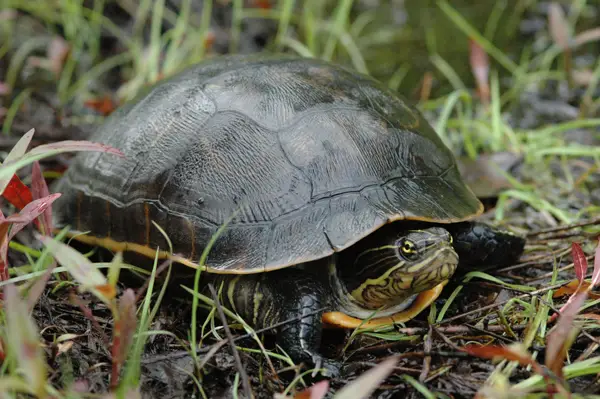
- Scientific name: Deirochelys reticularia reticularia
- Common name: Eastern Chicken Turtle
- Family: Emydidae
- Size: 5 to 10 inches
- Lifespan: 15 to 30 years
- Conservation status: Least Concern
Eastern chicken turtle is a sub-species of chicken turtle and resides in Mississippi Virginia, and North Carolina states.
It has an oval-shaped shell that’s dark brown or black in color. On top of this, its shell bears a relatively subtle pattern usually yellow in color.
The lower side of its shell is yellowish and the skin is dark colored and covered with yellow stripes.
Eastern chicken turtles can be found in canals, marshes, cypress, ponds, and other waterbodies that are still or sluggish. It has also been frequently found in sand hills.
For the diet part, chicken turtles are omnivorous and like eating meat, fish, snails, insects, aquatic vegetation, and land plant matter such as fruits and veggies.
An interesting fact: Chicken turtles are so named because of their meat taste, which was a popular delicacy back in the 1970s!
51. Western Chicken turtle
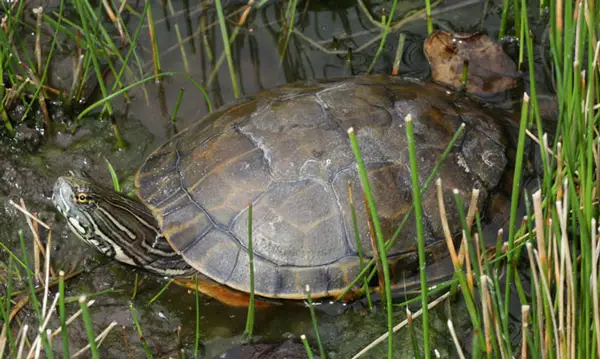
- Scientific name: Deirochelys reticularia miaria
- Common name: Western Chicken Turtle
- Family: Emydidae
- Size: 5 to 10 inches
- Lifespan: 15 to 30 years
- Conservation status: Least Concern
Western chicken turtle is another subspecies of chicken turtle species, native to the Mississippi, Missouri, Oklahoma, and Arkansas.
This species of turtle is regarded as the most social turtle species you’ll find in the US! They’re known to bask or swim in groups and rarely live or travel alone.
The easiest way to observe them is when they’re basking, since most of their activities, including reproduction and feeding, happen underwater.
Western chicken turtle shells are egg-shaped (oval) compared to other turtles and are black or dark brown in color. They also feature subtle yellow patterns. The lower side of the shell is usually yellow and the skin is dark and covered with yellow stripes.
These turtles prefer living in still water areas such as ponds, marshes, and ditches. However, it is also easy to spot them on land when they’re foraging for food or basking in the sun.
Western chicken turtles are omnivorous. They eat meat, fish, snails, insects, aquatic vegetation, and land plant matter.
52. Wood turtle
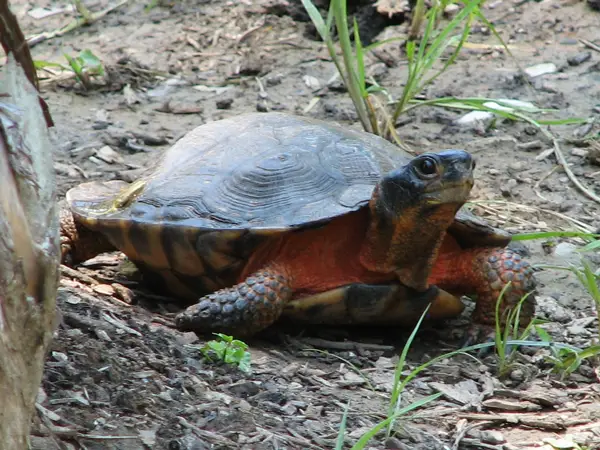
- Scientific name: Glyptemys insculpta
- Common name: Wood turtle, Sculptured Tortoise, Redleg, Red-legged Tortoise
- Family: Emydidae
- Size: 5.5 to 8 inches
- Lifespan: 40 to 60 years
- Conservation status: Endangered
Wood turtle species also inhabit the various woodland habitats across these states: Pennsylvania, Rhode Island, Vermont, New Hampshire, Ohio, Iowa, West Virginia, Michigan, and Minnesota.
They also tend to stay near the water and will frequently venture into it. During winter, they tend to hibernate at the bottom of deep rivers and pools.
The turtles get their name from their sculpted-like looks. Their upper shells are dark brown and have sport patterns resembling wood grain and growth rings.
Their scutes may sometimes appear like they’re pyramiding, further enhancing their sculpted shape.
Wood turtles are diurnal omnivores and their diet mainly consists of berries, plants, insects, and mollusks.
They forage for their food widely and have even been observed stomping their feet on the ground as a way of tricking the earthworms into surfacing.
53. Spotted Turtle
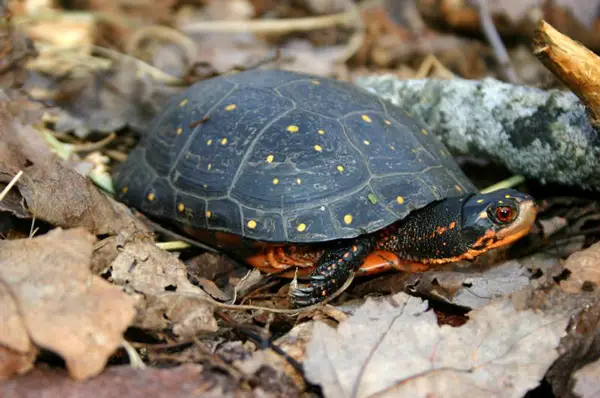
- Scientific name: Clemmys guttata
- Common name: Spotted Turtle
- Family: Emydidae
- Size: 4 to 5 inches
- Lifespan: 25 to 50 years
- Conservation status: Endangered
The Spotted turtles have been spotted in Vermont, Florida, Georgia, Connecticut, Delaware, Illinois, Maryland, Indiana, Maine, Michigan, New Hampshire, Rhode Island, New Jersey, Ohio, Massachusetts, Pennsylvania, New York, West Virginia, North Carolina, and Virginia.
The turtle resides in shallow marshes, swamps, and bogs. They’re semi-aquatic and are comfortable on land just as they are in the waters.
An adult spotted turtle has a smooth upper shell that ranges from olive to dark brown in color, with some light yellow spots. The neck and head feature irregular orange or yellow spots and streaks. Their tails are fairly long.
The turtles are omnivorous and their diet involves crustaceans, mollusks, insects, and plant matter (occasionally). Note that these turtles are aggressive hunters and will actively seek their prey.
Unfortunately, the population of spotted turtles is on the decline due to human interference and habitat loss. Their unique shell patterns make them a favorite species of a pet turtle for many people.
For this reason, they’re listed as endangered and protected by many governing bodies across various states.
Above all, the spotted turtles are incredibly smart. Studies carried on them using a maze even indicate that they have the same brain capacity as the mouse!
54. Blanding’s Turtle
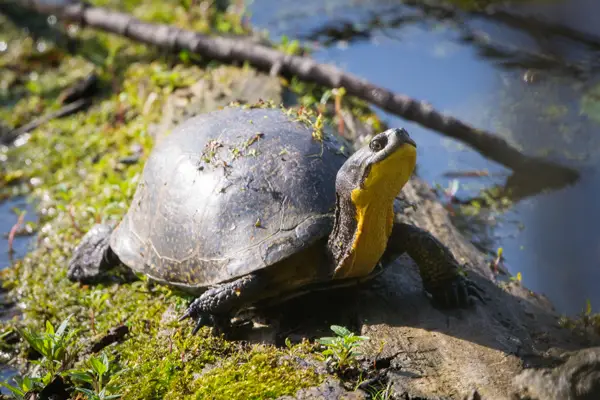
- Scientific name: Emydoidea blandingii
- Common name: Blanding’s Turtle
- Family: Emydidae
- Size: 5 to 8 inches
- Lifespan: up to 80 years (or more!)
- Conservation status: Endangered
The states where Blanding’s turtle has been spotted include Iowa, Nebraska, Illinois, Indiana, Maine, Michigan, Massachusetts, Missouri, New York, Minnesota, New Hampshire, Ohio, South Dakota, Pennsylvania, and Wisconsin.
Blanding’s Turtle is also known as the “turtle that smiles” and is named in honor of William Blanding, the American naturalist.
The species is semi-aquatic and is categorized as endangered species in the United States. Its population is quite scattered across various states—making it hard to find.
The Blanding turtle has a dark oval shell covered with faint yellow speckles. The lower side of its shell is usually yellow with black patches.
Blanding’s turtle prefers living in marshy habitats. And the fact that it’s losing these favorite habitats is one of the reasons causing its population to decline fast.
Because this turtle species is omnivorous, it feeds on leatherworks, crayfish, and aquatic invertebrates. It also occasionally feeds on plants and doesn’t rely on water to help it sallow its food as it’s the case with most turtle species.
55. Bog Turtle
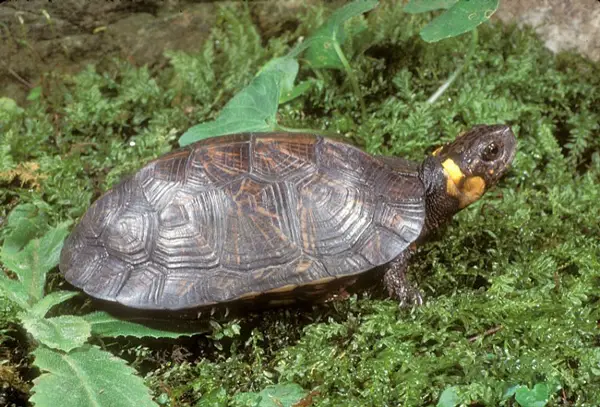
- Scientific name: Glyptemys muhlenbergii
- Common name: Bog Turtle, Muhlenberg’s turtle
- Family: Emydidae
- Size: 3.5 to 5 inches
- Lifespan: up to 40 years
- Conservation status: Critically Endangered
The Bog turtle is the smallest aquatic turtle you’ll find in North America. It inhabits these states: Connecticut, Georgia, Maryland, Virginia, South Carolina, Massachusetts, New Jersey, North Carolina, Pennsylvania, New York, and Tennessee.
The species is critically endangered and is one of the rarest turtles in many states. Selling or owning a bog turtle in most US states is illegal!
An adult bog turtle’s carapace coloration ranges from black to olive or dark brown and features a central keel ridge.
Some of the scutes making up their upper shell may also bear red or yellow-star markings. And their heads have distinctive orange or yellow patches.
The bog turtle is known to inhabit wetland areas such as marshes or bogs populated with grass cover.
The turtle species are diurnal omnivores and like eating insects, mollusks, and occasional vegetation. They’re most active during warm parts of the day.
Box Turtles:
56. Ornate Box Turtle
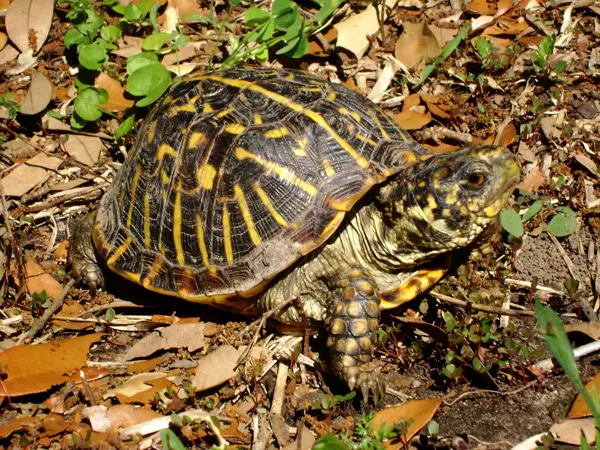
- Scientific name: Terrapene ornata
- Common name: Ornate Box Turtle, Western Box Turtle
- Family: Emydidae
- Size: 5 to 7 inches
- Lifespan: 40 to 60 years
- Conservation status: Near Threatened
Ornate box turtles are present in these US states: South Dakota, Arizona, Texas, Arkansas, Colorado, Iowa, Kansas, Wyoming, Louisiana, Nebraska, Illinois, Indiana, New Mexico, Missouri, Oklahoma, and Wisconsin.
They are recognized by the beautiful pattern on their carapace. This eye-pleasing pattern is sometimes referred to as a starburst pattern.
Their skin is grey and may feature yellow or white spots. Male heads occasionally feature green color.
Though there exists a little distinction between the males and females of these box turtles, males are generally smaller than females.
During hot weather, this turtle requires water to help regulate its body temperature.
The species of turtle are known to hibernate in burrows during cold weather. They’re also capable of surviving in frozen soils for several days.
Being omnivorous in nature, and opportunistic feeders, these turtles will gladly feed anything available to them in their habitat or what’s abundant in a given season.
They have been observed eating fruits, vegetables, grasshoppers, and various other insects.
57. Eastern Box Turtle
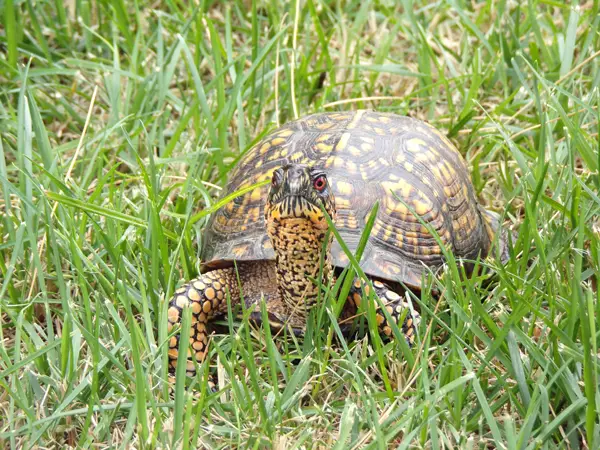
- Scientific name: Terrapene carolina
- Common name: Eastern Box Turtle, Land turtle, Box Turtle
- Family: Emydidae
- Size: 4.5 and 7 inches
- Lifespan: 50 to 100 years
- Conservation status: Vulnerable
The eastern box turtles are found in Kansas, Delaware, Florida, Alabama, Connecticut, Georgia, Kentucky, Maine, Maryland, Illinois, Indiana, Massachusetts, Michigan, New Jersey, New York, Mississippi, New Hampshire, North Carolina, Ohio, South Carolina, Tennessee, Pennsylvania, Rhode Island, West Virginia, and Virginia.
They usually inhabit dense thickets and woodland areas. They prefer these areas due to abundant access to sunlight and food sources nearby.
An adult turtle of this species is about 4.5 to 7 inches and weighs just 2lbs. It has a high, domed shell shape with a ridge running from head to toe. The shell of this turtle has varying colors of olive, brown, and tan.
The variation in markings on the shells of these turtles is so variable that you can’t easily recognize one by looking at the shell alone.
These eastern box turtles are omnivorous and feed on a variety of foods, including insects, meat, fruits, vegetables, and various types of vegetation.
Note that eastern box turtles are taken from the wild for pet trade, leading to a decline in their population. For this reason, many states have illegalized capturing and selling of this species.
And those in captivity end up dying due to poor conditions or being abandoned or released back into the wild because they’re too demanding to maintain.
58. Florida Box Turtle
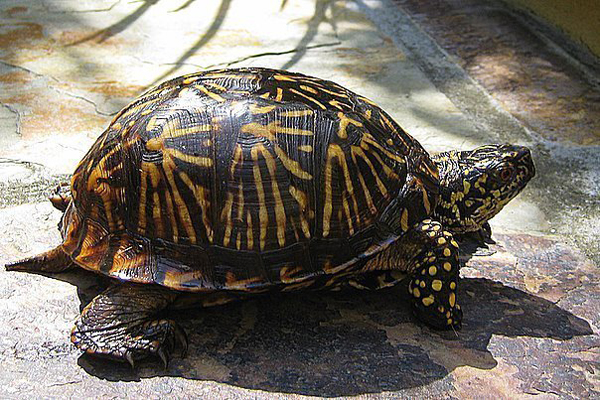
- Scientific name: Terrapene bauri
- Common name: N/A
- Family: Emydidae
- Size: 4.5 to 6.5 inches
- Lifespan: 25 to 30 years
- Conservation status: Vulnerable
The Florida box turtle is native to the state of Florida and the extreme southeastern part of Georgia.
Its distribution is widespread throughout Florida’s mainland, though it has also been observed in the Florida Keys region.
As one of the 4 common box turtle subspecies, this box turtle’s natural habitat involves the swamps, marshes, and forests. The turtle likes lying in water but it doesn’t swim as often.
This box turtle has a dark (almost black shell) with impressive orange markings along with yellow stripes on its head.
Being omnivorous in nature, this turtle will eat snails, insects, earthworms, slugs, mushrooms, strawberries, and green-leafed vegetation. They have also been spotted eating quail eggs.
Florida box turtle is fairly small and tolerant to handling, making it a good pet choice. However, the law forbids owning more than two of these turtle species without a permit.
59. Three-Toed Box Turtle
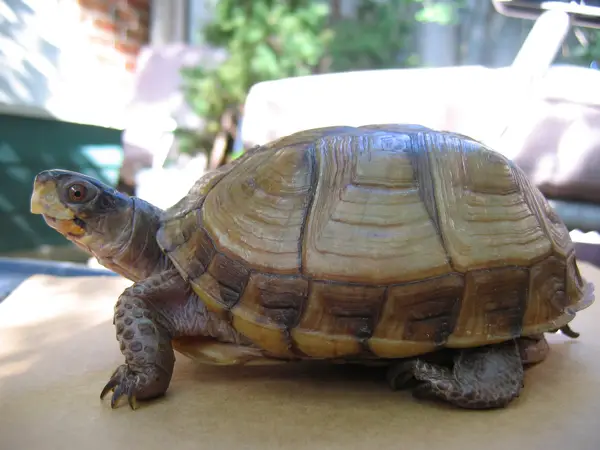
- Scientific name: Terrapene triunguis
- Common name: N/A
- Family: Emydidae
- Size: 4.5 to 5 inches
- Lifespan: 50 and 100 years
- Conservation status: Vulnerable
The three-toed box turtles inhabit the thickets, prairies, and woodlands of Alabama, Georgia, Louisiana, Florida, Missouri, Mississippi, Tennessee, Oklahoma, and Texas.
They’re easily identifiable by the 3 toes on their hind limbs, unlike the usual 4 toes on other box turtle species.
They have a uniform olive to brown shell color, sometimes with light spots or streaks. Bright yellow or orange spots are also occasionally spotted on the turtle species’ head and leg.
A mature three-toed box turtle has an average size of 4.5 to 5 inches.
They are unlike other box turtles in that they’re the only species that will remain healthy if you have them in indoor enclosures.
Being omnivorous in nature, these turtles are known to eat snails, insects, earthworms, slugs, mushrooms, strawberries, and green-leafed vegetation. They have also been spotted eating quail eggs.
60. Gulf Coast Box Turtle
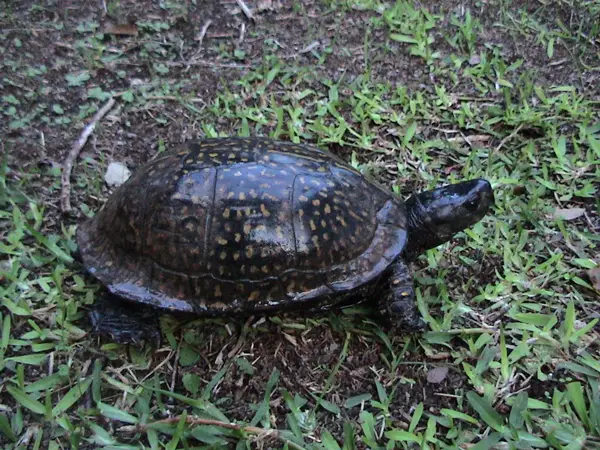
- Scientific name: Terrapene carolina major
- Common name: Gulf Coast box turtle
- Family: Emydidae
- Size: 6 to 8.5 inches
- Lifespan: 30 to 40 years
- Conservation status: Not extinct
The gulf coast box turtle is the largest of all the common box turtle subspecies. The turtle prefers living near Mississippi brackish waters, swamps, and estuaries.
It likes residing in warm and humid conditions.
The gulf coast box turtle has a dark brown or black shell with a fluted edge and yellow stripes or dots.
As for the skin, it is much darker than other box turtle species and ranges from black to dark brown.
This gulf coast box turtle is omnivorous. And its diet is mainly made up of insects, amphibians, and mollusks. It also occasionally feeds on plant matter.
Similar to the eastern box turtle above, this turtle also makes a good choice for a pet turtle.
Related: Turtles in Mississippi
Sea Turtle Species:
61. Green Sea Turtle
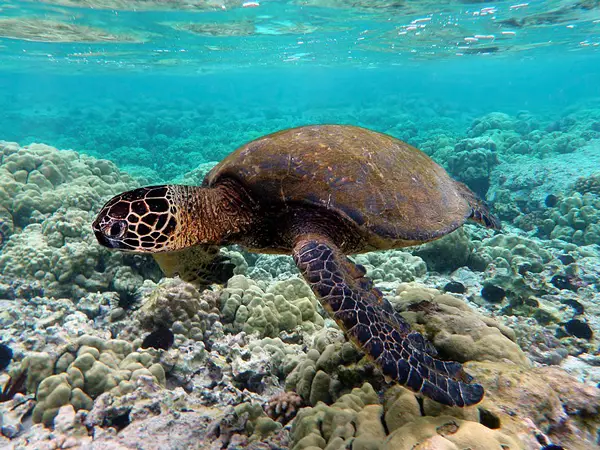
- Scientific name: Chelonia mydas
- Common name: Green turtle, Pacific green turtle, Black sea turtle
- Family: Cheloniidae
- Size: 2 to 5 feet
- Lifespan: 60 to 70 years
- Conservation status: Endangered
The green sea turtle species is classified among the largest hard-shelled sea turtles in the US and is common in states like Texas, Washington, Virginia, South Carolina, Hawaii, Florida, North Carolina, Alabama, and Alaska, among others.
This species is characterized by scutes that run down the middle; they’re 4 on each side. The shell color can be gray, dark brown, or olive with a yellow-to-white bottom shell or plastron.
It also features a serrated beak on its lower jaw and two large scales resign between the eyes.
Males are generally larger than females and have longer tails. The females lay their eggs on the beach and use their paddle-shaped flippers to easily burrow in the sand when laying eggs. A single green turtle can lay up to 200 eggs!
This sea turtle species gets its name from its primary diet which consists of age and seagrasses (mind you, this diet is responsible for tinting its cartilage green).
Green turtles are usually found in tropical as well as subtropical waters throughout the years. They also tend to migrate to cooler temperatures and even boreal waters when the weather gets warmer.
62. Loggerhead Sea Turtle
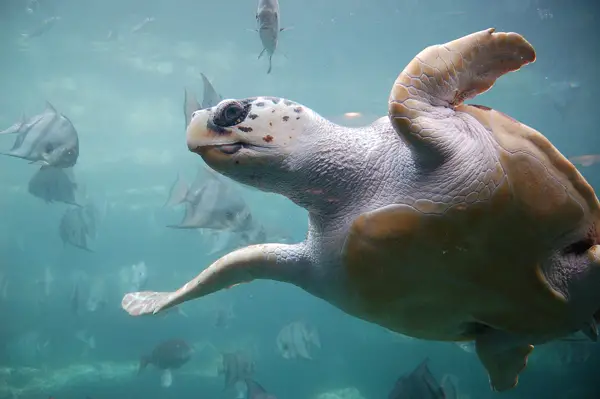
- Scientific name: Caretta caretta
- Common name: Loggerhead, Loggerhead Sea-Turtle
- Family: Cheloniidae
- Size: 3.5 feet
- Lifespan: 70+ years
- Conservation status: Endangered
Loggerhead sea turtles boast their place as the most abundant sea turtle species in the United States and are found in many states, including Alabama. Rhode Island, Florida, Texas, Washington, North Carolina, New Jersey, Oregon, and Virginia.
These turtles are pretty big and can reach up to 3.5ft in length. They weigh up to 350 pounds and can live for a whopping 70 years or more.
A loggerhead is distinguished by a slightly heart-shaped carapace that’s reddish brown in color, with pale yellow plastron. Some species also feature yellow-bordered scutes.
This turtle species gets its name from its large head. It has powerful jaws that enable it to feed on a variety of foods including conch, whelks, insects, jellyfish, gastropods, and algae.
The loggerhead turtles are usually found in temperate, tropical, and subtropical waters all year round. However, they also tend to migrate to cold boreal waters on rare occasions, for instance, during El Nino weather.
63. Leatherback Sea Turtle
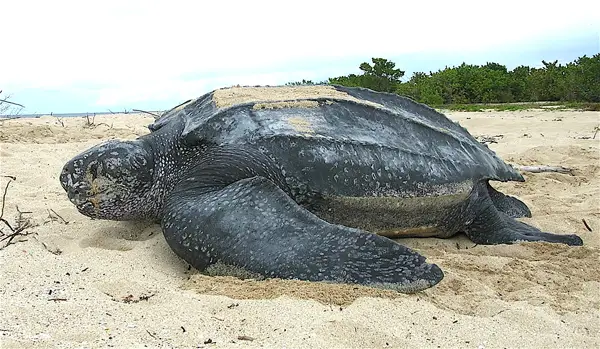
- Scientific name: Dermochelys coriacea
- Common name: leathery turtle, trunk turtle, Lute turtle, luth
- Family: Dermochelyidae
- Size: 5 to 6 feet
- Lifespan: 50+ years
- Conservation status: Vulnerable
The leatherback sea turtles are also found in multiple US states including Rhode Island, Alabama, North Carolina, Washington, South Carolina, Virginia, Florida, Massachusetts, Mississippi, and Connecticut.
These turtles are known to grow to mammoth sizes (up to 6 feet!). An average adult can also weigh as heavy as 540lbs!
Leatherback turtles usually have black shells. And they differ from other species of turtles with their smooth leathery carapace and skin. Their upper shell is made up of a flexible layer of dermal bones covered by tough and oily connective tissue and smooth skin.
The body of this turtle is barrel-shaped and then tapered to the rear. They have a total of 7 longitudinal dorsal ridges and their whole body is almost completely black, with some variable spotting.
Leatherback turtles have tooth-like cusps that work closely with their sharp-edged jaws to enable them to easily feed on jellyfish, salps, and other gelatinous zooplankton.
As for the habitat, these turtles are fond of tropical and subtropical waters all year round. But they tend to migrate to cooler, temperate, and boreal waters during warm weather.
Note that this species is highly migratory and can swim as many as 10,000 miles in a year between foraging and nesting grounds. They’re also excellent divers—with the deepest diving record standing at whopping 4,000 feet!
64. Kemp’s Ridley Sea Turtle
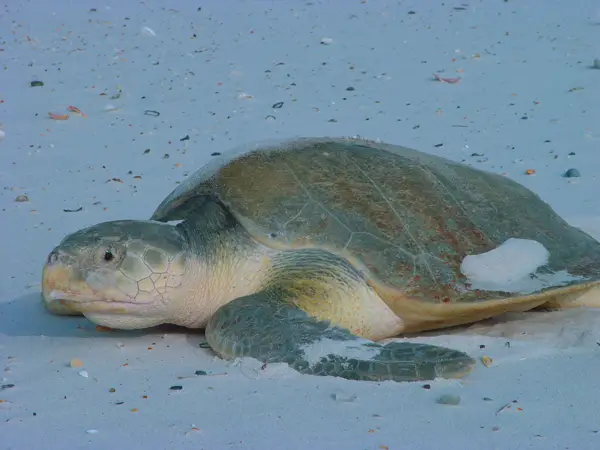
- Scientific name: Lepidochelys kempi
- Common name: Atlantic ridley sea turtle,
- Family: Cheloniidae
- Size: 2+ feet
- Lifespan: 30+ years
- Conservation status: Critically endangered
Kemp’s ridley sea turtle is the smallest species of all the sea turtles in the US and is found in states like Rhode Island, North Carolina, South Carolina, Texas, Mississippi, Virginia, and New Jersey, among others.
The average adult size is about 2 feet and weighs approx. 110 lbs. They have adapted flippers (front limbs) and a beak.
This turtle is the rarest sea turtle species and is one of the world’s most endangered species. The species is called Kemp’s ridley because Richard Moore Kemp of Key West was the first to send its specimen to Samuel Garman at Harvard university. However, the origin of the name ridley is still unclear.
Note that these turtles tend to change their color as they age. Baby turtles feature dark purple color along the sides which turns into yellow-green as they mature.
Kemp Ridley is also the only sea turtle that nests during the day.
These turtles also practice Arribada nesting, which involves all the females nesting together in a tight group. This helps them protect themselves better from predators as well as help their hatchlings easily make it to the open ocean.
65. Olive Ridley Sea Turtle
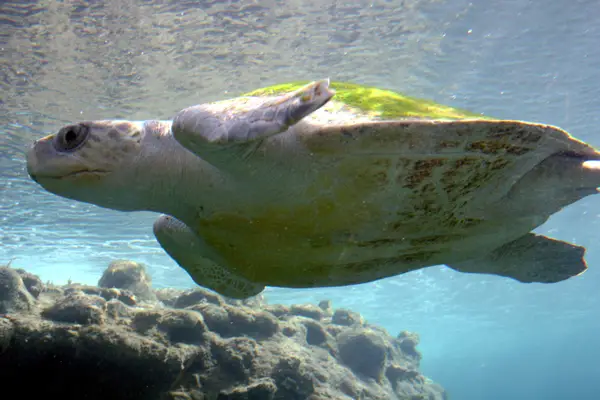
- Scientific name: Lepidochelys olivacea
- Common name: Pacific ridley sea turtle
- Family: Cheloniidae
- Size: 2.5 feet
- Lifespan: 50 years
- Conservation status: Vulnerable
Olive ridley sea turtles are present in Hawaii, Alaska, California, Oregon, and Washington.
These sea turtles are much smaller than other species of sea turtles. They reach a maximum of 2.5 feet in length and weigh up to 100 pounds. And they have an average lifespan of up to 50 years.
An olive ridley sea turtle has a heart-shaped carapace with olive to grayish-green in color. The shell features around 5 to 9 scutes. These turtles are generally omnivorous and feed on crustaceans, fish, jellyfish, mollusks, algae, and salps.
These sea turtles can opt to nest in large groups or by themselves. In the event of a mass nesting, the female turtles usually gather in large groups offshore on the nesting beaches.
This is then followed by a vast number of turtles moving ashore to nest (this event is usually referred to as arribada, a Spanish word for arrival).
The arribada is marked by numerous (hundreds of thousands) pregnant females coming ashore to lay eggs. Due to the high density of nesting experienced at the nesting beaches, the females end up digging up clutches of eggs laid by other females as they try to find a place for their eggs.
Olive ridley turtles are usually found in tropical and subtropical waters all year round. Though they tend to migrate to boreal waters when the climate gets warmer.
66. Hawksbill Sea Turtle
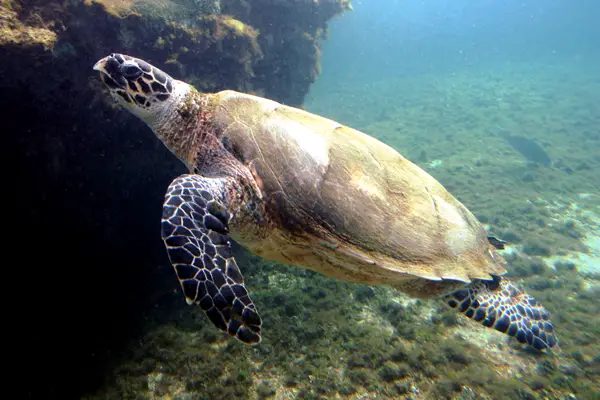
- Scientific name: Eretmochelys imbricata
- Common name: hawksbill turtle
- Family: Cheloniidae
- Size: 2.5 to 3 feet
- Lifespan: 50 to 60 years
- Conservation status: Critically endangered
Hawksbill sea turtles have been found in many states including Alabama, Virginia, North Carolina, Maryland, Hawaii, Massachusetts, Maryland, Texas, Florida, and South Carolina.
The adult has an average size of 3 feet and weighs around 180 pounds. The shell of this turtle features amber upper shell with irregular light and dark streaks. They also feature predominant black and molten-brown easily radiating to the sides.
The shell tends to change color depending on the water temperatures.
This colored and patterned shell makes this turtle highly valuable and is commonly sold as “tortoiseshell” in the markets.
The hawkbill turtle is so named due to its narrow, pointed beak. It also has a distinctive pattern of overlapping scales on its shells which form a serrated look on the edges.
These turtles mainly feed on the sponge which they easily extract from reef crevices with the help of their narrow, pointed beaks. They also feed on jellyfish.
Hawkbill turtles are generally found in tropical oceans throughout the world. While they live in the open ocean, they tend to spend more time in various coral reefs and shallow lagoons across the US.
During nesting, a female hawkbill turtle will look for small coves, “pocket” beaches, or inlets surrounded by rocks. They tend to travel high up the beach to lay eggs in shelters formed by the plants.
Conclusion
That’s our complete list of turtles in the United States. The list is pretty long and diverse. It features all types of turtles ranging from snapping turtles, map turtles, box turtles, pond turtles, mud turtles, musk turtles, softshells, painted turtles, and even sea turtles.
These turtles are widespread across all 50 states of the US. Some states like Alabama offer favorable living conditions for these turtles and boast more diverse lists than others.
Despite the US enjoying such diversity in turtle species, a good number of its native species have been classified as vulnerable, threatened, or endangered and are under protection by state and federal authorities.
These threats face various threats in the US, including habitat loss and destruction, overharvesting of the wild turtles, illegal trafficking of the turtles, climate change, exotic invasive turtle species, or diseases.
Death from roads, predators, agriculture machinery, or hunting has also contributed to the declining population of these endangered or threatened turtles.
